von
Chrystina Häuber
Der folgende Text enthält Literaturangaben und viele Abbildungsnummern. Vergleiche FORTVNA PAPERS vol. III-1, S. 1097 ff. für die entsprechenden Bildunterschriften ("List of illustrations"), S. 1128, für die Abkürzungen ("Abbreviations") , und S. 1129 ff., für die Literatur ("Bibliography") .
Im folgenden Text wird häufig auf Passagen in FORTVNA PAPERS vol. III-1 hingewiesen; cf. https://FORTVNA-research.org/FORTVNA/FP3.html
Dieser
Text, eine Preview meines Buches über Domitian in FORTVNA PAPERS vol. III-2,
ist ein Ergebnis der Preview mit folgendem Titel:
Chrystina Häuber, Die neuesten
Forschungsmeinungen zu folgenden Themen in 9 Kapiteln:
Hadrian / Konstantin in Rom
- die Kolossalstatue in Rom, die in ein
Bildnis Konstantins des Großen umgearbeitet worden ist
- die Fragmente der Kolossalstatue Konstantins
des Großen im Konservatorenpalast in Rom -
- umgearbeitet aus Domitians Kultbild des
Iuppiter Optimus Maximus Capitolinus?
- oder umgearbeitet aus dem Kultbild des Divus Hadrianus im Hadrianeum in Rom?
- die im Maßstab 1:1 rekonstruierte
Kolossalstatue Konstantins des Großen in den Musei Capitolini, im Giardino der
Villa Caffarelli
cf.
<https://fortvna-research.org/FORTVNA/FP3/Konstantin_Hadrian_Koloss_01.html>:
Further research on those subjects has led to
results, which are presented in the following text, written in English and
divided into three Chapters. In this text are quoted many passages from the
Preview "Hadrian / Konstantin in Rom", which was published in German.
For this new text, those passages were translated into English.
Let's begin with the German titles of these
three Chapters, followed by English translations of them:
I.) Das kolossale Konstantinportrait (hier Figs. 11; 11.1; 156) kann nicht, wie Claudio Parisi Presicce (2022)
vorgeschlagen hat, aus Domitians (viertem) Kultbild des Iuppiter Optimus
Maximus Capitolinus umgearbeitet worden sein. Dieses Jupiterkultbild war
nämlich, wie Birgit Bergmann (2010a) feststellt, mit einem Eichenkranz bekränzt
(vergleiche hier Figs. 13; 158),
eine Tatsache, die mir zuvor unbekannt gewesen ist. Das Konstantinportrait
(hier Fig. 11) hat aber mit
Sicherheit nie einen Kranz getragen.
Dieser
Text enthält außerdem Zusammenfassungen von Themen, die in der Preview "Hadrian / Konstantin in Rom" in
folgenden Kapiteln behandelt werden; vergleiche Kapitel 1: Die Motivation,
diesen Text zu verfassen: Claudio Parisi Presicces (2022) Rekonstruktion des
Konstantinkolosses (hier Fig. 156);
Kapitel 2, Punkt 1.): Cécile Evers' Beweis, dass der Kopf des Konstantinkolosses
(hier Fig. 11) aus einem Portrait
des Hadrian umgearbeitet worden ist; Kapitel 2, Punkt 1.)-Kapitel 7: Parisi
Presicces (2005; 2006a; 2006b; 2022) Beobachtungen zu Domitians (viertem)
Kultbild des Iuppiter Optimus Maximus Capitolinus; Kapitel 2, Punkt 2.):
Die vier Tempel des Iuppiter Optimus Maximus Capitolinus und ihre vier
Kultbilder; Kapitel 3: Die Kopien von Domitians (viertem) Kultbild des Iuppiter
Optimus Maximus Capitolinus; Kapitel 5-Kapitel 6: Parisi Presicces (2006b;
2022) Beobachtungen zur Konstantinstatue in Rom, die Eusebius (Hist. Eccl. 9,9,10-11) beschrieben hat;
Kapitel 6-Kapitel 7: Parisi Presicces (2022) Vorschlag, dass der Koloss des
Konstantin (hier Figs. 11; 11.1; 156)
aus Domitians (viertem) Kultbild des Jupiter Capitolinus umgearbeitet worden
sei, und meine Widerlegung dieser Hypothese; Kapitel 9: Meine eigene Hypothese,
dass der Koloss des Konstantin möglicherweise aus dem Kultbild des Divus Hadrianus im Hadrianeum umgearbeitet worden sei.
I.) Claudio Parisi Presicce's hypothesis (2022), according to which
the colossal portrait of Constantine (here Figs.
11; 11.1; 156) has been reworked from Domitian's (fourth) cult-statue of
Iuppiter Optimus Maximus Capitolinus, cannot possibly be true, and that for the
following reasons. As observed by Birgit Bergmann (2010a), this cult-statue of
Jupiter (cf. here Figs. 13; 158) was
crowned with an oak wreath, a fact that was previously unknown to me. The
portrait of Constantine (here Fig. 11),
on the other hand, has certainly never worn a wreath.
In
addition, this text contains summaries of subjects, that are discussed in the
following Chapters of the Preview "Hadrian
/ Konstantin in Rom"; cf. Kapitel 1: the motivation to write this
text: Claudio Parisi Presicce's (2022) reconstruction of the colossus of
Constantine (here Fig. 156); Kapitel
2, at point 1.): Cécile Evers's proof, that the head of the colossus of
Constantine (here Fig. 11) has been
reworked from a portrait of Hadrian; Kapitel 2, at point 1.)-Kapitel 7: Parisi
Presicce's (2005; 2006a; 2006b; 2022) observations concerning Domitian's
(fourth) cult-statue of Iuppiter Optimus Maximus Capitolinus; Kapitel 2, at
point 2.): the four Temples of Iuppiter Optimus Maximus Capitolinus
and their four cult-statues; Kapitel 3: the copies of Domitian's (fourth)
cult-statue of Iuppiter Optimus Maximus Capitolinus; Kapitel 5-Kapitel 6:
Parisi Presicce's (2006b; 2022) observations concerning the statue of
Constantine in Rome, which has been described by Eusebius (Hist. Eccl. 9,9,10-11); Kapitel 6-Kapitel 7: Parisi Presicce's
(2022) suggestion, that the colossus of Constantine (here Figs. 11; 11.1; 156) has been reworked from Domitian's (fourth)
cult-statue of Jupiter Capitolinus, and my rejection of this hypothesis;
Kapitel 9: my own hypothesis, that the colossus of Constantine has possibly
been reworked from the cult-statue of Divus
Hadrianus in the Hadrianeum.
II.) Claudio Parisi Presicce (2022, 389) behauptet (irrtümlich),
dass Domitians Kultbild des Jupiter Capitolinus in der erhobenen, rechten Hand
einen Globus mit darauf stehender Victoriastatuette hielt (vergleiche hier Fig. 10). Erst nachdem die Preview zum
Thema "Hadrian / Konstantin in Rom"
(am 24. September 2024) auf unserem Webserver publiziert war (siehe Kapitel 4),
hat Franz Xaver Schütz (am 7. Oktober 2024) das Exemplar von Domitians Denar
mit Darstellung seines (vierten) Tempels des Iuppiter Optimus Maximus
Capitolinus in der Bibliothèque Nationale de France gefunden, auf dem noch sehr
viel besser als auf der Münze im British Museum erkennbar ist (die uns bereits
bekannt war), dass Domitians Jupiter Capitolinus mit seiner rechten, auf dem
rechten Oberschenkel ruhenden, Hand ein Blitzbündel hielt. Wir bilden hier
deshalb jetzt beide Exemplare dieser Münze auf Fig. 83 ab.
II.) Claudio Parisi Presicce (2022, 389) asserts (erroneously) that
Domitian's cult-statue of Jupiter Capitolinus held in his right, raised hand a
globe surmounted by a standing statuette of Victory (cf. here Fig. 10). Only after the Preview "Hadrian / Konstantin in Rom" had
been published on our Webserver (on 24th September 2024; see Kapitel 4), Franz
Xaver Schütz has found (on 7th October 2024) the copy of Domitian's denarius with the representation of his
(fourth) Temple of Iuppiter Optimus Maximus Capitolinus, kept in the
Bibliothèque Nationale de France. On this coin it is much better visible than
on the coin in the British Museum (which we knew already before) that
Domitian's Jupiter Capitolinus held with his right hand a thunderbolt which was
lying on his right thigh. We, therefore, illustrate here on Fig. 83 both copies of this coin.
III.) Wie Cécile Evers (1991) nachgewiesen hat;
vergleiche
die Preview "Hadrian / Konstantin
in Rom", Kapitel 2, zu Punkt 1.);
cf.
<https://fortvna-research.org/FORTVNA/FP3/Konstantin_Hadrian_Koloss_02.html>,
- war
das Portrait des
Konstantinkolosses (vergleiche hier Fig.
11) aus einem Bildnis des Kaisers Hadrian umgearbeitet worden. Nota bene:
Als Evers ihren Aufsatz publizierte, ging die Forschung noch davon aus, dass
für die Konstantinstatue (hier Figs. 11;
11.1; 156) Teile von verschiedenen
kolossalen Marmorstatuen wiederverwendet worden waren.
Dank der
von ihm in Auftrag gegebenen Marmortests konnte jedoch Claudio Parisi Presicce
(2005; 2006b; 2022) inzwischen klarstellen, dass statt dessen der gesamte
Konstantinkoloss aus einer einzigen
Statue umgearbeitet worden war, die aus der besten Qualität parischen Marmors,
namens lychnites, bestand.
Da diese
originale Statue Hadrian barfuss zeigte, habe ich vorgeschlagen (s.o., in Band
3-1, S. 498-499, 726, 729, 737-738, 758), dass sie den vergöttlichten Kaiser,
den Divus Hadrianus, dargestellt
habe, wobei es sich, meiner Meinung nach, um das Kultbild des Divus Hadrianus im Hadrianeum gehandelt haben könnte.
Nachdem
diese Forschungen in der Preview "Hadrian
/ Konstantin in Rom" auf unserem Webserver publiziert waren (siehe
Kapitel 8), habe ich diesen Text einigen Kollegen und Freunden geschickt und
sie gefragt, wie sie die Barfüßigkeit dieses kolossalen Hadrianportraits deuten
würden.
Lorenzo
Cigaina schrieb mir Folgendes: "Die Barfüßigkeit könnte wohl auf den
göttlichen bzw. [beziehungsweise] vergöttlichten Status hindeuten, wie man es
bei der berühmten Prima-Porta-Statue des Augustus festgestellt hat".
Und John
Pollini antwortete auf meine diesbezüglich Frage: "In the Prima Porta
statue, Augustus also appears as a hero, one who was mortal but possessed
divinity in life (therefore of a dual nature)".
Im
Zusammenhang meiner Diskussion mit Eberhard Thomas, wie man wohl das Problem
gelöst haben könnte, das hier betrachtete Bildnis des vergöttlichten Hadrian in
ein Portrait des (noch lebenden) Kaisers Konstantin umzuwandeln, wies mich
Eberhard darauf hin, dass man diesem barfüßigen Hadrianbildnis womöglich
Sandalen angezogen hat (!). Wie ich erst daraufhin festgestellt habe, sind an
beiden Füßen des Konstantinkolosses in sehr flachem Relief die Riemen von
Sandalen eingetieft. Ich vermute deshalb als Arbeitshypothese, dass diese
Reliefdarstellungen von Sandalenriemen im Zusammenhang der Umwandlung des
originalen Hadrianportraits in ein Bildnis des Konstantin ausgeführt worden
sind, um dem Künstler, der diese Sandalen ergänzt hat, als Hilfslinien zu
dienen.
III.) As Cécile Evers (1991) was able to prove;
see the
Preview "Hadrian / Konstantin in
Rom", Kapitel 2, at point 1.);
cf.
<https://fortvna-research.org/FORTVNA/FP3/Konstantin_Hadrian_Koloss_02.html>,
- the portrait of the colossus of
Constantine (cf. here Fig. 11) had
been reworked from a portrait of the Emperor Hadrian. Nota bene: When Evers
published her article, scholars still believed that the statue of Constantine
(here Figs. 11; 11.1; 156) had been
created by re-using parts of different
colossal marble statues.
In the
meantime, Claudio Parisi Presicce (2005; 2006b; 2022) has been able to clarify,
thanks to marble tests which he has ordered, that instead the entire colossus
of Constantine has been reworked from only one single statue, that had been sculpted from the best quality
of Parian marble, called lychnites.
Because
this original statue had represented Hadrian with bare feet, I have suggested
(cf. supra, in vol. 3-1, pp. 498-499,
726, 729, 737-738, 758) that this statue had represented the divinized emperor,
Divus Hadrianus, and that, in my
opinion, this could possibly have been his cult-statue in the Hadrianeum.
After
this research had been published on our Webserver in the Preview "Hadrian / Konstantin in Rom" (see
Kapitel 8), I have sent this text to some colleagues and friends, asking them
how they themselves judge the bare feet of this colossal portrait of Hadrian.
Lorenzo
Cigaina wrote me the following: "Die Barfüßigkeit könnte wohl auf den
göttlichen bzw. [beziehungsweise] vergöttlichten Status hindeuten, wie man es
bei der berühmten Prima-Porta-Statue des Augustus festgestellt hat".
And John
Pollini answered my relevant question: "In the Prima Porta statue,
Augustus also appears as a hero, one who was mortal but possessed divinity in
life (therefore of a dual nature)".
Eberhard
Thomas, with whom I had discussed the question, how the problem may have been
solved to rework the portrait of the divinized Hadrian, discussed here, into
one of the (still living) Emperor Constantine, alerted me to the fact that the
bare feet of this portrait of Hadrian may have been dressed with sandals (!).
Only after Eberhard's suggestion have I realized that on both feet of the
colossus of Constantine have been sculpted in very low relief the straps of
sandals. I, therefore, suggest as a working hypothesis, that those straps of
sandals may be explained with the transformation of the original portrait of
Hadrian into one of Constantine, and that the straps served as guidelines for
that artist, who added those sandals.
Let's
begin our discussion by looking at the illustrations, which are mentioned in
the Preview "Hadrian / Konstantin
in Rom";
cf.
<https://fortvna-research.org/FORTVNA/FP3/Konstantin_Hadrian_Koloss_01.html>,
and in
the following text.
Please
note that the coins and medallions, which we publish here, are not illustrated
in their original sizes. For some more figures, which are discussed in the
Preview "Hadrian / Konstantin in
Rom", but not in the following text; cf.
https://fortvna-research.org/FORTVNA/FP3/Hadrian_Hierapydna_statue.html>.
ILLUSTRATIONS
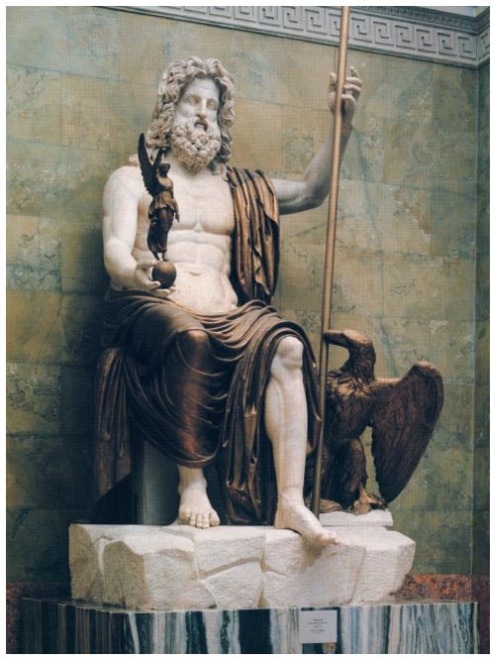
Fig. 10. Colossal acrolithic statue of
Jupiter. St. Petersburg, Hermitage (inv. no. ГР-4155), from Castel Gandolfo.
Height: 3,47 m. From: C. Parisi Presicce (2006b, 146, Fig. 47, copied after M.B.
PIOTROVSKIJ and O.J. NEVEROV 2003, fig. on p. 200).
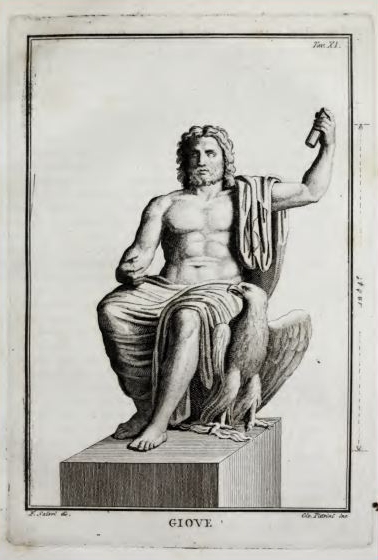
Fig. 10.1. Giuseppe Antonio Guattani (1805,
Tav. 11), drawing of Vincenzo Pacetti's first restoration of the colossal
marble statue of Jupiter from Castel Gandolfo in the Hermitage at St.
Petersburg (here Fig. 10).
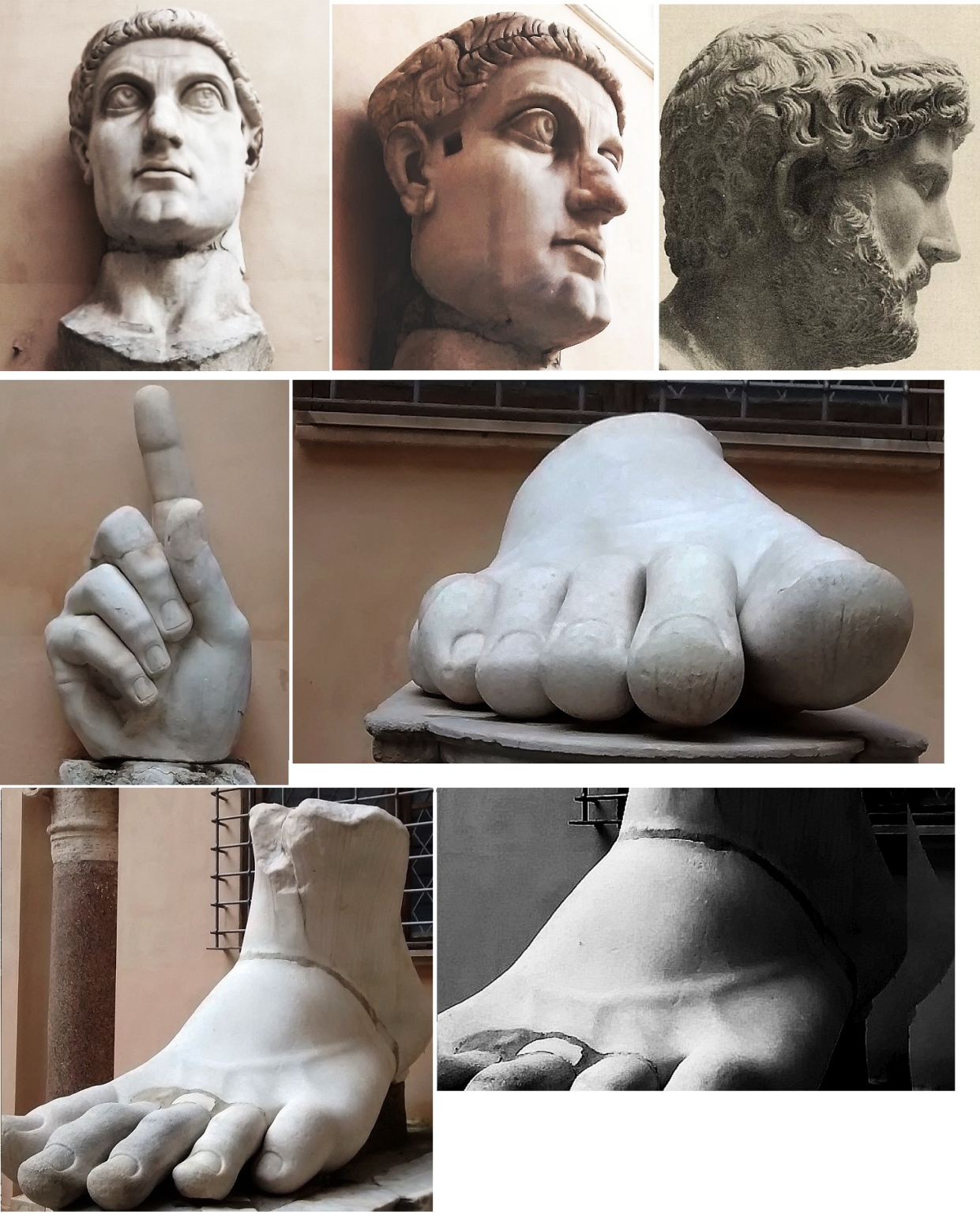
Fig. 11. Colossal acrolithic statue of Hadrian (now Constantine the Great). Roma, Musei Capitolini, Palazzo dei Conservatori,
Cortile. For the nine fragments in the Cortile (MC, inv. 757; inv. 784; inv. 785; inv. 789; inv. 791; inv. 793, inv. 794; inv. 798; MC, dep. 12); cf. C. Parisi
Presicce (2006b). Cf. infra, for the tenth fragment.
C. Evers (1991) has proven that this portrait of Constantine has been reworked from a portrait of Hadrian of his `Rollocken-Portraittypus´.
Compare the right profile of Constantine's head, at which still some of Hadrian's curls called `Rollocken´ are preserved, with the right profile of the portrait
of Hadrian of his `Rollocken-Portraittypus´ in Sevilla, with the same kind of curls; cf. M. Wegner, Hadrian, Plotina, Marciana, Matidia, Sabina,
Berlin 1956, 13: "Sevilla, Museo Arqueologico Provincial, Sala VIIIa", Taf. 11, right.
At the bottom right appears the black and white version of the photo of Constantine's left foot; to the left of it you see the colour photograph.
This black and white photo shows more clearly than the two colour photographs of both feet that on these feet there are represented in very low relief the straps of
sandals. The ten extant fragments of this colossus (cf. here Fig. 11.1, on which they are are all represented) were carved from the best quality of Parian marble,
called lychnites, and were found within and near the Basilica of Maxentius.
The height of the head (without the modern addition of its neck) is 1,74 m. Nine fragments are kept at Roma, Musei Capitolini, Palazzo dei Conservatori,
courtyard.
The tenth fragment, "A portion of the left chest, 126 centimeters high, with the shoulder and arm attachment ... is currently housed in a storage
room of the Parco archeologico del Colosseo (formerly in the first cloister of the Church of Santa Francesca Romana, site of the Antiquarium of the Roman Forum)
[ILL. 18] [my emphasis]"; cf. C. Parisi Presicce (2022, 405, with n. 51. This is the fragment, found by H. Kähler (1951; published by him in 1952).
Photos of the fragments in the courtyard of the Palazzo dei Conservatori: Courtesy of F.X. Schütz (06-III-2020).
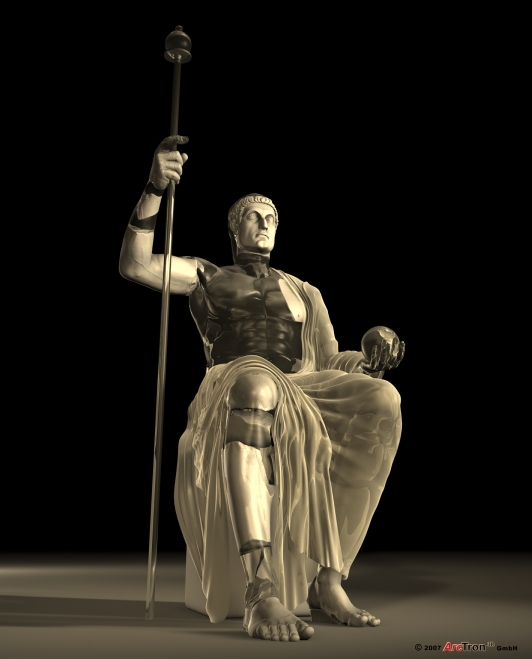
Fig. 11.1. "Ricostruzione virtuale del
colosso di Costantino realizzata da Konstantin-Ausstellungsgesellschaft Trier
mbH, Musei Capitolini e ARCTRON3D"; cf. C. Parisi Presicce 2006b, 147,
caption of Fig. 48; cf. p. 127, note *). Courtesy of C. Parisi Presicce.
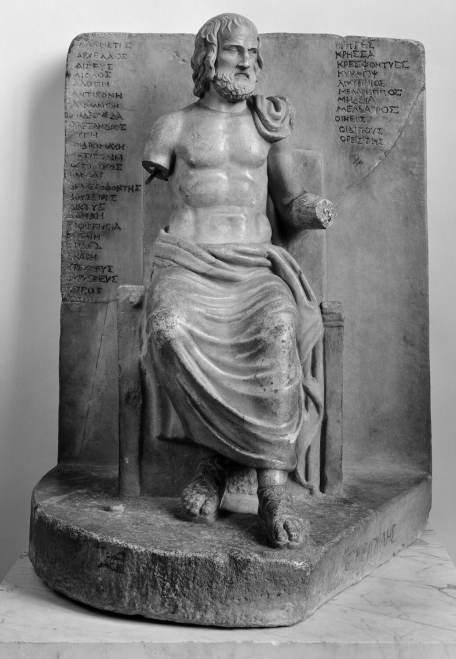
Fig. 12. Statuette of the seated `Euripides´,
marble. Paris, Louvre (MA 343). This figure represented originally Jupiter in
the Capitoline Triad. Cf. H.R. Goette ("From Father god to tragic poet
...", forthcoming).
Photo: © Musée du Louvre, Dist. GrandPalaisRmn / Maurice et Pierre Chuzeville.
Collection: Département des Antiquités grecques, étrusques et romaines.
Permalink: https://collections.louvre.fr/ark:/53355/cl010277111 (online: 21.1.2025)
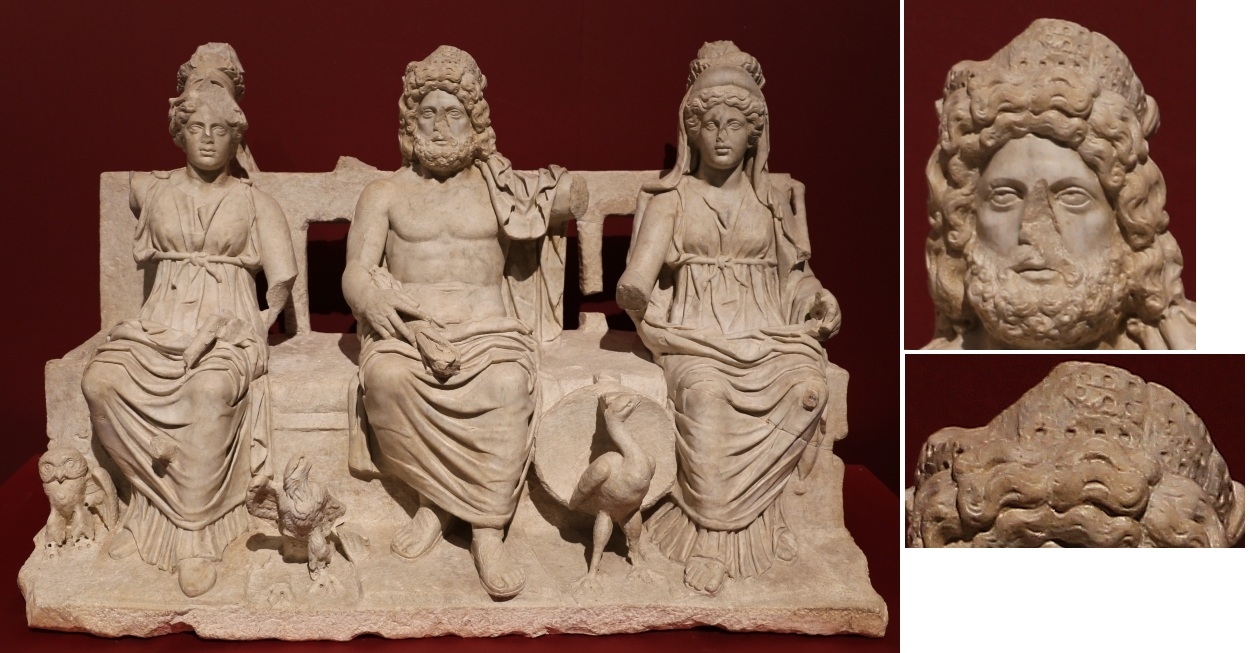
Fig. 13. Statuette of the Capitoline Triad,
marble. Represented are the cult-statues of Domitian's (fourth) Temple of
Iuppiter Optimus Maximus Capitolinus: Jupiter, Juno and Minerva; the
cult-statue of Jupiter is wearing an oak wreath. Guidonia Montecelio (Roma),
Museo Civico Archeologico `Rodolfo Lanciani´ (inv. no. 80546). Cf. Z. Mari, in:
F. Buranelli (2019, 73: "20. Triade Capitolina Fine del II-inizi III
secolo. Scultura a tutto tondo in marmo lunense, quasi integra (parzialmente
mancanti alcuni arti delle figure e attributi); lungh. cm 119, largh. cm 53, h.
max. cm 80. Dal Comune di Guidonia Montecelio (Rm), loc. Tenuta dell'Inviolata
- Quarto Campanile, Guidonia Montecelio, Museo Civico Archeologico ``Rodolfo
Lanciani´´ (già nel Museo Nazionale di Palestrina fino al 2012). Inv. no.
80546. Furto 1992 (scavi clandestini), Guidonia Montecelio (Roma). Recupero:
1994, Livigno (Sondrio))".
Photo: Triade Capitolina, Museo Civico
Archeologico Rodolfo Lanciani, Guidonia Montecelio Author: Sailko, CC BY 3.0
Deed (https://creativecommons.org/licenses/by/3.0/deed.en).
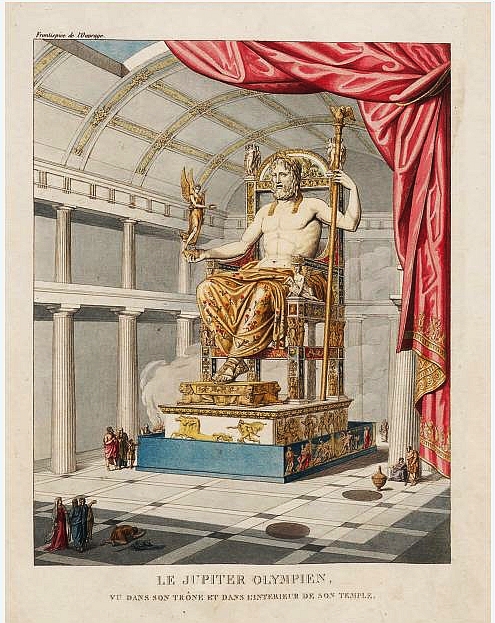
Fig. 14. Reconstruction drawing of the
cult-statue of Zeus in his Temple at Olympia, one of the Seven Wonders of the
ancient (Western) World, a chryselephantine statue made by Phidias (440-430
BC). Coloured lithography by Antoine Chrysostôme Quatremère de Quincy, from his
book Le Jupiter olympien (1815). Cf.
S. Faust (2022, 9-10, "Abb. 1 Zeus von Olympia, Rekonstruktion der Statue
und des Tempelinnenraumes. Farbige Lithographie von A. C. Quatremère de Quincy.
Universitätsbibliothek Heidelberg digital, Quatremère de Quincy, 1815,
Frontispiz)".
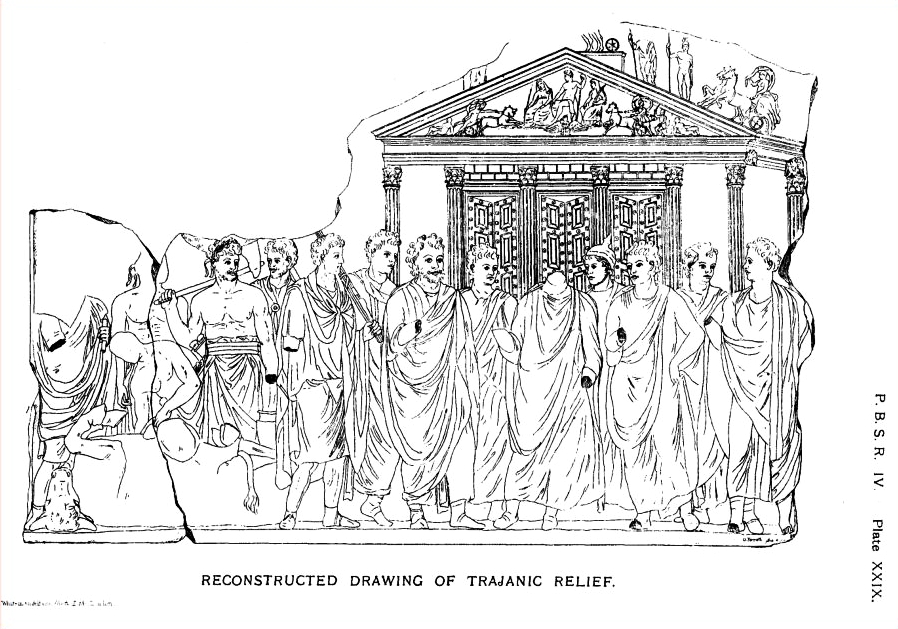
Fig. 16. A.J.B. Wace. Reconstruction drawing
of the Extispicium Relief in the Louvre (MA 978), based on the extant fragments
of this relief, and for the lost parts on Renaissance drawings. The relief
shows the extispicium rite performed
in front of Domitian's (fourth) Temple of Iuppiter Optimus Maximus Capitolinus
and was found in the Forum of Trajan; cf. A.J.B. Wace 1907, 229-244. From:
A.J.B. Wace 1907, 238, Pl. XXIX. Cf. A. Claridge (1998, 238, Fig. 110; ead. 2010, 270, Fig. 113).
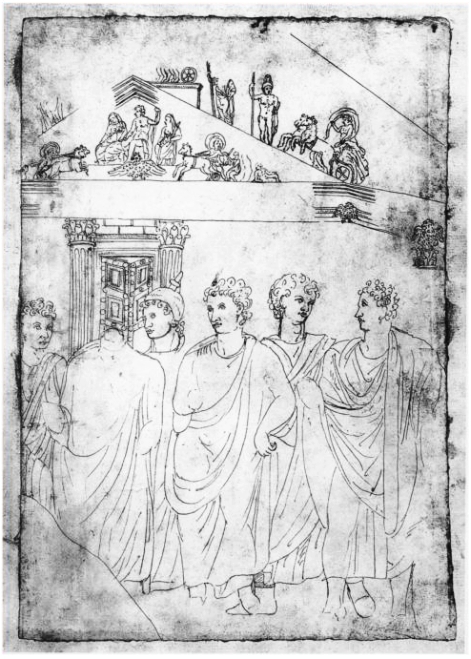
Fig, 17. Renaissance drawing of the right-hand
part of the Extispicium Relief in the Louvre (MA 978), on which in the
background appears the façade of Domitian's (fourth) Temple of Iuppiter Optimus
Maximus Capitolinus. Cod. Vat. Lat. 3439 F. 83. From. A.J.B. Wace 1907, 240, Pl.
XX.
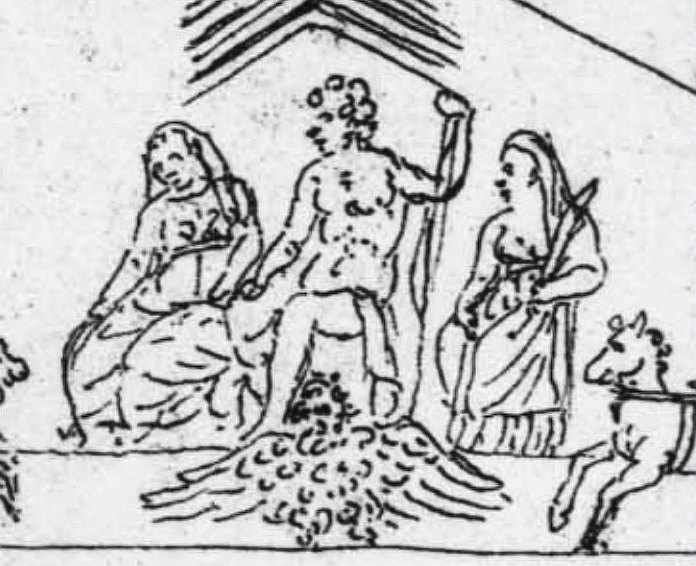
Fig. 17, detail. Renaissance drawing of the
right-hand part of the Extispicium relief in the Louvre (MA 978), on which in
the background appears the façade of Domitian's (fourth) Temple of Iuppiter
Optimus Maximus Capitolinus. Cod. Vat. Lat. 3439 F. 83. From: A.J.B. Wace 1907,
240 Pl. XX. This detail shows part of the pediment of Domitian's Temple of
Iuppiter Optimus Maximus Capitolinus.
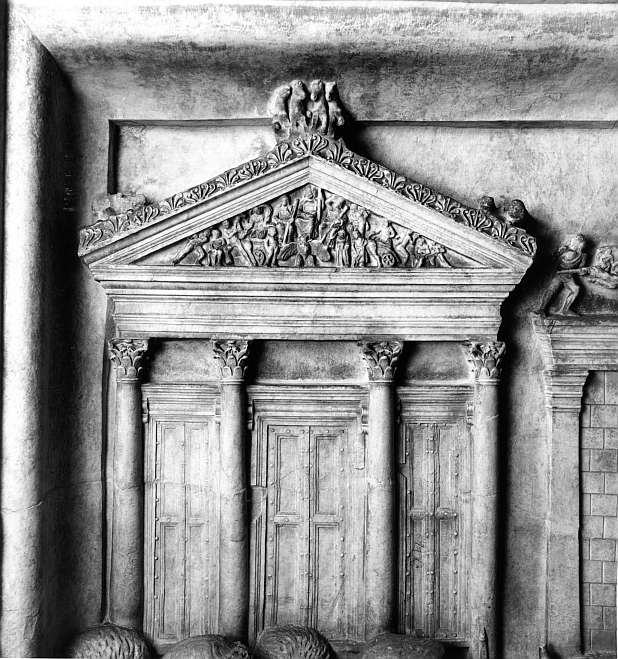
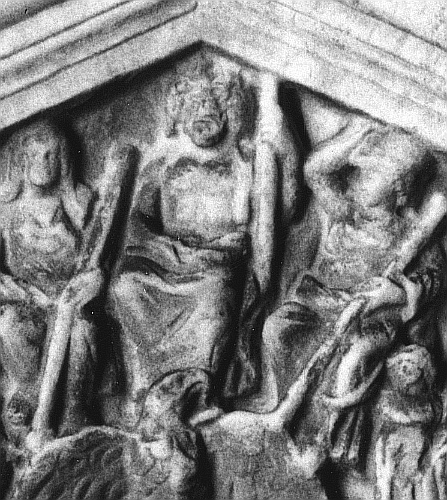
Fig. 19. Marcus Aurelius, `Pietas Augusti´, marble relief, representing a sacrifice in front of Domitian's (fourth) Temple of Iuppiter
Optimus Maximus Capitolinus. Musei Capitolini, Palazzo dei Conservatori, staircase (inv. no. 807/S). Archivio Fotografico dei Musei Capitonini,
Neg. nos. d.13102; d. 13103. Photo: Pasquale Rizzo. © Roma, Sovraintendenza Capitolina ai Beni Culturali. Fig. 19 shows Domitian's
Temple of Iuppiter Optimus Maximus Capitolinus with its pediment. Here are represented the three cult-statues.
The detail of this photo on the right shows Domitian's seated cult-statue of Jupiter Capitolinus,
holding with his right hand his thunderbolt, which is lying on his lap.
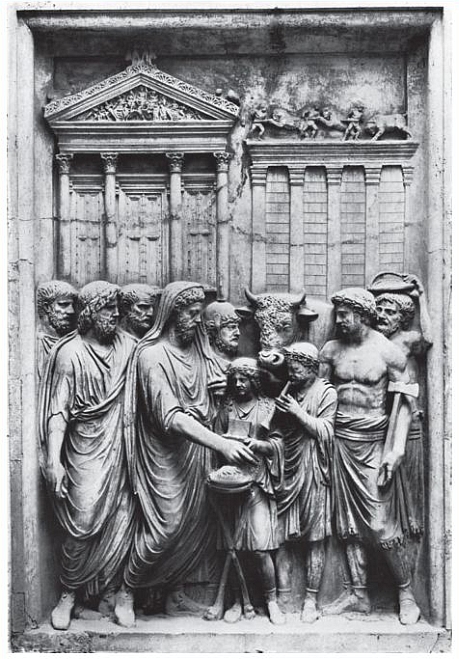
Fig. 19a. Marcus Aurelius, `Pietas Augusti´,
marble relief, representing the sacrifice at the end of Marcus Aurelius'
triumph (of AD 176), celebrated in front of Domitian's (fourth) Temple of
Iuppiter Optimus Maximus Capitolinus. Musei Capitolini, Palazzo dei
Conservatori, staircase (inv. no. 807/S). From: T. Hölscher (2016, 302, Abb.
9.4): "Triumph-Opfer des Marc Aurel auf dem Kapitol. Nach: I. Scott Ryberg,
Panel Reliefs of Marcus Aurelius (1967) pl. XV". R. Bianchi Bandinelli and
M. Torelli (1976, "Arte Romana", scheda 142) wrote: "si tratta
del sacrificio prescritto al termine del trionfo".
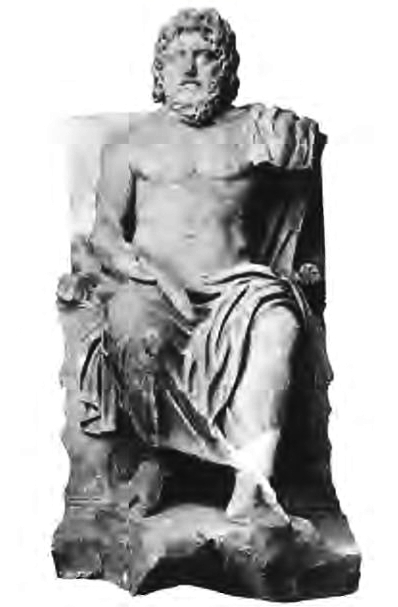
Fig. 20. Marble statuette of M. Bossert's
(2000) statue-type "Iuppiter Capitolinus". Rome, Via Appia Nuova. The
caption of M. Bossert's Abbildung 14, which is illustrated here, reads:
"Iuppiter Capitolinus von der Via Appia Nuova, Rom (Italien). Marmor,
H[öhe] 80 cm".
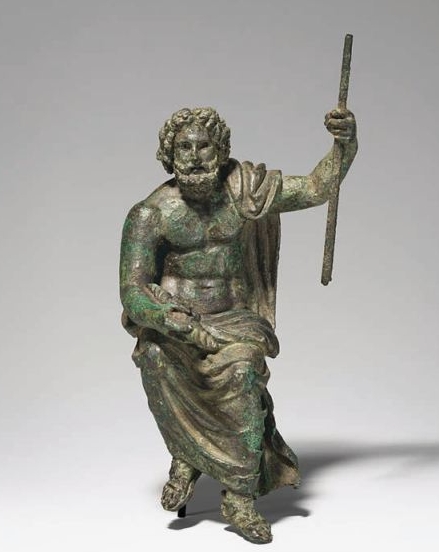
Fig. 20.1. Bronze statuette representing the `Capitoline
Jupiter´, datable to the 1st or 2nd century AD.
Cf. S. Faust (2022, 22-24, Abb.
4: "Bronzestatuette des Jupiter Capitolinus 1.-2. Jh. n. Chr., New York,
Metropolitan Museum of Art
(Open Access/Public Domain [CCO]
https://www.metmuseum.org/art/collection/search/246686)". (online: 21.1.2025)
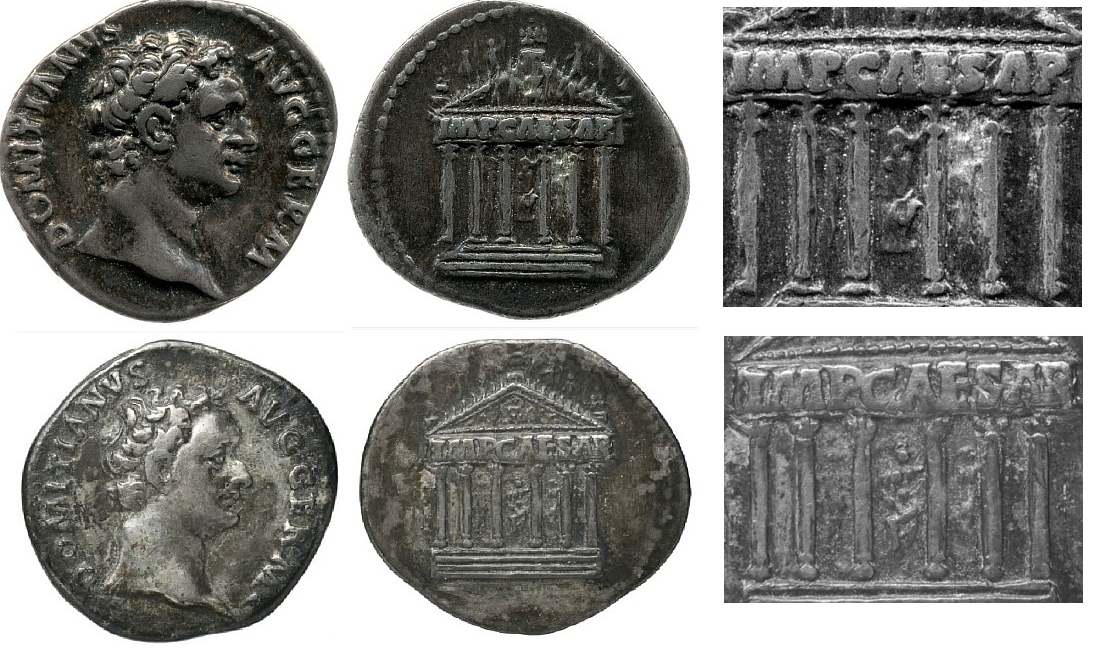
Fig. 83. Denarius,
issued by Domitian in Rome in AD 95/96, London, British Museum (BMC 242),
reverse, representing Domitian's (fourth) Temple of Iuppiter Optimus Maximus
Capitolinus. Only on the denarius of
the Bibliothèque Nationale de France, which is also illustrated here, it is
very well visible that Domitian's seated cult-statue of Jupiter Capitolinus is
holding with his right hand his thunderbolt that is lying on his lap.
Cf. R.H. Darwall-Smith (1996, 107-110, 280,
Fig. 34 on Plate XX): Unfortunately we were unable to verify Darwall Smith's
assertion that the coin, which he discusses and illustrates, is kept in the
Ashmolean Museum. There are altogether four copies of this coin known: at the
"American Numismatic Society; Bibliothèque Nationale de France;
Münzkabinett Berlin; and the British Museum", but the copy illustrated by
Darwall-Smith (op. cit.) is not among
those four coins. For this list, and for illustrations of the first three
coins; cf. http://numismatics.org/ocre/id/ric2_1(2).dom.815 [9-X-2024].
For the copy of this coin in the British
Museum, illustrated here; cf. C. Parisi Presicce and E. Dodero (2023, 67, ns. 31, 32, Fig.
3 [= here Fig. 83] cf. supra, in vol.
3-1, pp. 720-723): The British Museum, Museum number R.11170. "Obverse:
Head of Domitian, bare, right. Inscriptions: DOMITIANVS AVG GERM and IMP CAESAR
(inscription on architrave). Reverse: Temple of Capitoline Jupiter, six
columns, with Jupiter seated and two figures flanking him, between columns".
RE2 / Coins of the Roman Empire in the British Museum, vol. II: Vespasian to
Domitian (242, p. 346); RIC2.1 / The Roman Imperial Coinage, vol.2 part 1: From
AD 69 to AD 96: Vespasian to Domitian (815, p. 325).
© The Trustees of the British Museum. Shared
under a Creative Commons Attribution-NonCommercial-ShareAlike 4.0 International
(CC BY-NC-SA 4.0) licence.
Courtesy of the Bibliothèque Nationale de
France. Public domain.
https://gallica.bnf.fr/ark:/12148/btv1b10447826z (22.1.2025)
Cf. supra,
in volume 3-1, pp. 1268-1270, in: The
first Contribution by Peter Herz on the inscription (CIL VI 2059.11), which reports on a meeting of
the Arval brethren on 7th December 80 at the Temple of Ops in Capitolio, among them Titus and Domitian: Titus vows
to restore and dedicate what would become Domitian's (fourth) Temple of
Iuppiter Optimus Maximus Capitolinus; see below, in: Appendix I.g.1.) Domitian's denarii, issued in AD 95/96, documenting some of the buildings he erected at
Rome (cf. here Figs. 80-84), inter alia
allegedly representing his Temple of Iuppiter Custos. These coins show in
reality Domitian's Temple of Isis and his Temple of Serapis within his Iseum
Campense and his Temple of Iuppiter Optimus Maximus Capitolinus ...; see
also below, in: Appendix I.g.4.) Domitian's sacellum of Iuppiter Conservator, his Temple of Iuppiter Custos, and his
(fourth) Temple of Iuppiter Optimus Maximus Capitolinus (cf. here Fig. 83). With The first Contribution by Peter
Herz.
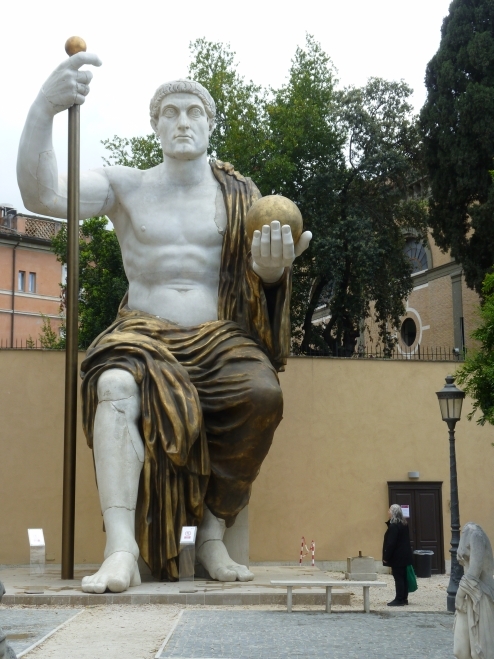
Fig. 156. Reconstruction at the scale 1 : 1 of
the colossal acrolithic statue of Hadrian (now Constantine the Great) at the
Musei Capitolini in Rome, in the Giardino di Villa Caffarelli. For a detailed
documentation, why and how the reconstruction was created in this way: cf. C. Parisi Presicce (2022).
Since the 6th of February 2024 it is on display there. H: allegedly circa 13 m. In reality, this
statue is only a maximum of 10 m high, as the comparison with me on this photo
shows: I am 1,68 m `high´ (comprising my shoes).
This reconstruction was based on the 10 extant
fragments of this colossal portrait; cf. here, Figs. 11; 11.1.
In the following, I will quote some passages
from the following Press Release:
"Comunicato Stampa, ROMA, Assessorato
alla Cultura, Sovrintendenza Capitolina ai Beni Culturali, MUSEI IN COMUNE
ROMA, and FACTVM FOVNDATION FOR DIGITAL TECHNOLOGY IN PRESERVATION, Roma, 6
febbraio 2024":
"La statua, alta circa 13 metri, è stata
realizzata attraverso tecniche di ricostruzione innovative, partendo dai pezzi
originali del IV secolo d.C. conservati nei Musei Capitolini ...
la straordinaria ricostruzione del Colosso in
scala 1:1, [è] risultato della collaborazione tra la Sovrintendenza Capitolina,
Fondazione Prada e Factum Foundation for Digital Technology in Preservation con
la supervisione scientifica di Claudio Parisi Presicce, sovrintendente
capitolino ai Beni Culturali ...
Il Giardino di Villa Caffarelli, dove è stata
collocata la riproduzione del Colosso di Costantino, insiste in parte sull'area
occupata dal Tempio di Giove Ottimo Massimo, che un tempo ospitava la statua di
Giove, la stessa forse da cui il Colosso fu ricavato o che comunque ne
costituisce il modello di derivazione. I resti del tempio sono oggi visibili
all'interno dell'Esedra di Marco Aurelio ...
I nove frammenti in marmo pario, attualmente
conservati presso i Musei Capitolini, sono stati rinvenuti nel 1486 ... Un
decimo frammento, parte del torace, rinvenuto nel 1951 [this is the fragment,
found by Heinz Kähler, which he has published in 1952], è in procinto di essere
trasferito dal Parco Archeologico del Colosseo nel cortile del Palazzo dei
Conservatori, accanto agli altri frammenti ...
La complessa operazione di ricostruzione
realizzata da Factum ha tenuto conto di molteplici fattori ... Dopo aver
ultimato il modello 3D ad altissima risoluzione, si è poi proceduto con la
ricostruzione materiale del Colosso. Resina e poliuretano, insieme a polvere di
marmo, foglia d’oro e gesso, sono stati scelti come materiali per rendere le
superfici materiche del marmo e del bronzo, mentre per la struttura interna ...
è stato impiegato un supporto in alluminio facilmente assemblabile e
rimovibile". Photo: Courtesy of F.X. Schütz (23-IV-2024).
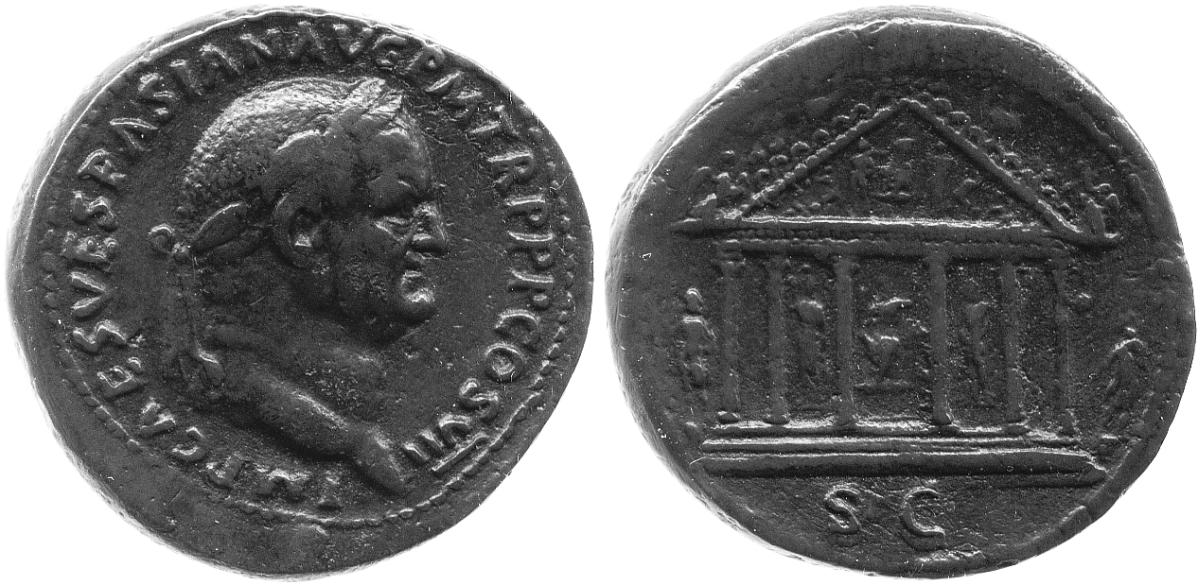
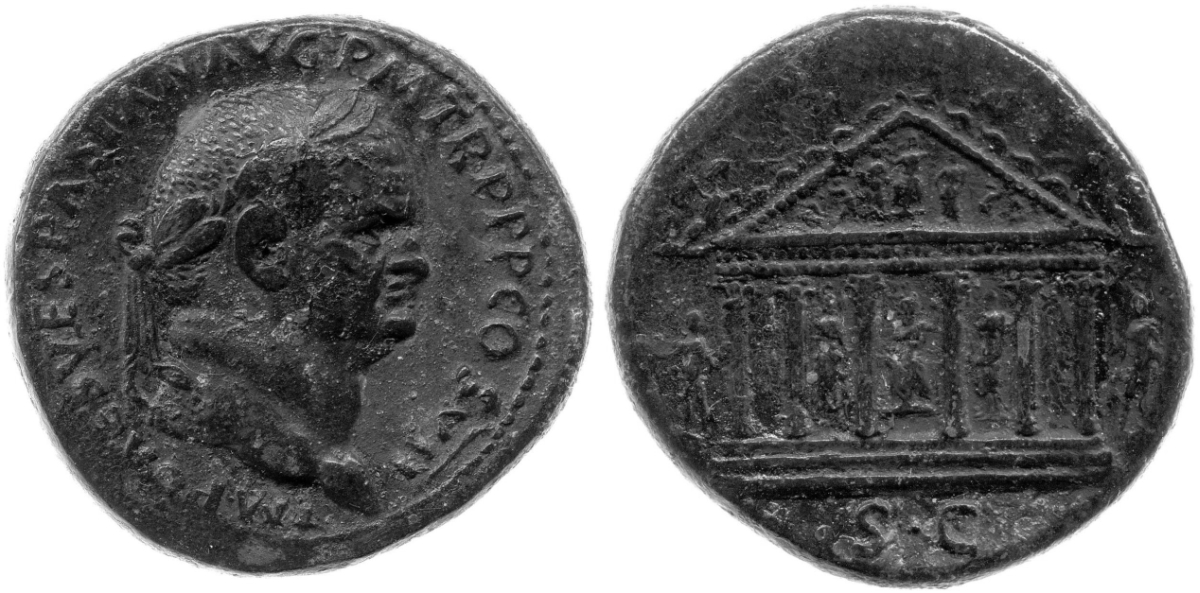
Fig. 157a. Two Sestertii, issued by Vespasian in Rome in 76 AD (RIC II 577, BMCRE 721, pl. 29.6 [= Fig. 157a, left];
and BMCRE 722, pl. 29.5 [= Fig. 157a, right]).
"Bibliographic references: RE2 / Coins of the Roman Empire in the British Museum, vol.II: Vespasian to Domitian (721, p.168)
RIC2.1 / The Roman Imperial Coinage, vol.2 part 1: From AD 69 to AD 96: Vespasian to Domitian (886, p.123)"
RE2 / Coins of the Roman Empire in the British Museum, vol.II: Vespasian to Domitian (722, p.168)
Both coins are described as follows: "Copper alloy coin , sestertius, Minted in: Rome (city), 76 AD".
Obverse: "Head of Vespasian, laureate, right, Inscription content: IMP CAES VESPASIAN AVG P M TR P P P COS VII".
Reverse: "Temple of Capitoline Jupiter with six columns. Inscription content: S C"
The reverses of these coins show that the cult-statue of Iuppiter Optimus Maximus Capitolinus in Vespasian's (third) temple of the god was
holding with his right hand the thunderbolt which was lying on his right thigh.
https://www.britishmuseum.org/collection/object/C_R-10631 (22.1.2025)
https://www.britishmuseum.org/collection/object/C_1872-0709-480
© The Trustees of the British Museum. Shared under a Creative Commons Attribution-NonCommercial-ShareAlike 4.0 International (CC BY-NC-SA 4.0) licence.
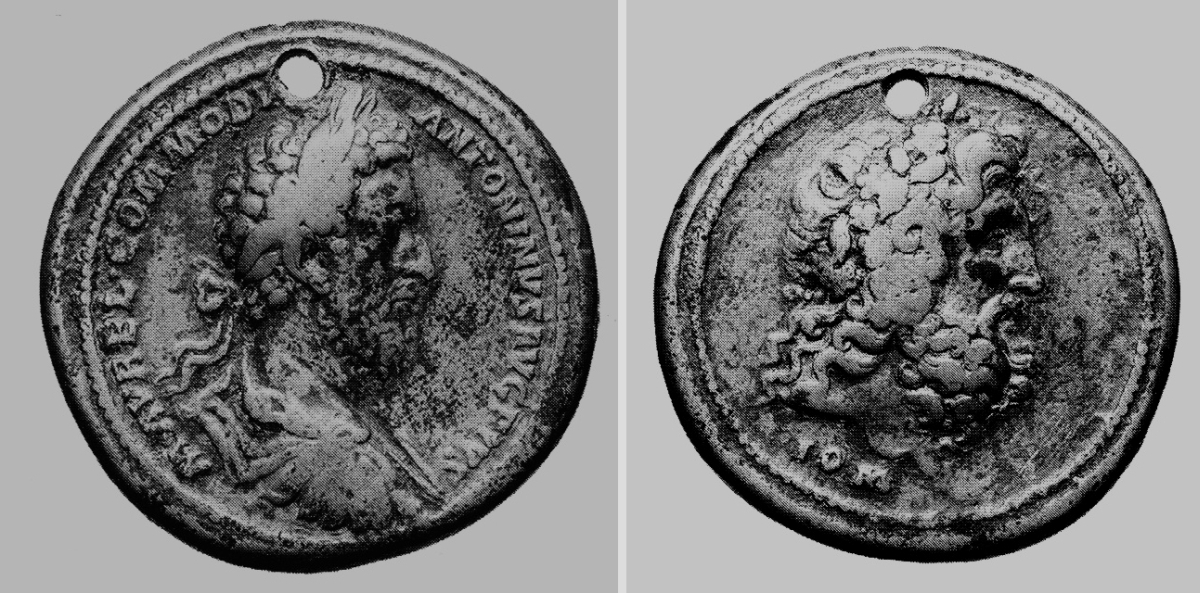
Fig. 158. Bronze medallion of Commodus, issued
in Rome. From: B. Bergmann (2010a, 79, 389-390, Kat. Nr. 63, Abb. 27). Date:
"10.-31.12. 183 n. Chr.; Paris, Bibliothèque nationale de France; Avers:
Kopf des Commodus nach re[chts] mit Kranz. Bei dem Kranz handelt es sich um
einen dichten Lorbeerkranz, der hinten mit einem Band in einer deutlich
sichtbaren Schleife geschlossen ist. Die Enden des Bandes fallen im Nacken
herab. Li[nks]: M AVREL COMMODVS; re[chts] ANTONINVS AVG PIVS; Revers: Kopf des
bärtigen Iuppiter nach re[chts] mit Kranz. Bei diesem Kranz handelt es sich um
einen dichten Eichenkranz ohne Tänie, in dem verschiedentlich auch Eicheln
dargestellt sind; Li[nks] unten: IOM ...
ABBILDUNG: Paris, Bibliothèque nationale de
France (Monnaies Médailles et Antiques [Me 260])".
Let's
now turn to the first Chapter of my new Text:
I.) Claudio Parisi Presicce's hypothesis (2022), according to which
the colossal portrait of Constantine (here Figs.
11; 11.1; 156) has been reworked from Domitian's (fourth) cult-statue of
Iuppiter Optimus Maximus Capitolinus, cannot possibly be true, and that for the
following reasons. As observed by Birgit Bergmann (2010a), this cult-statue of
Jupiter (cf. here Figs. 13; 158) was
crowned with an oak wreath, a fact that was previously unknown to me. The
portrait of Constantine (here Fig. 11),
on the other hand, has certainly never worn a wreath.
In
addition, this text contains summaries of subjects, that are discussed in the
following Chapters of the Preview "Hadrian
/ Konstantin in Rom"; cf. Kapitel 1: the motivation to write this
text: Claudio Parisi Presicce's (2022) reconstruction of the colossus of
Constantine (here Fig. 156); Kapitel
2, at point 1.): Cécile Evers's proof, that the head of the colossus of
Constantine (here Fig. 11) has been
reworked from a portrait of Hadrian; Kapitel 2, at point 1.)-Kapitel 7: Parisi
Presicce's (2005; 2006a; 2006b; 2022) observations concerning Domitian's
(fourth) cult-statue of Iuppiter Optimus Maximus Capitolinus; Kapitel 2, at
point 2.): the four Temples of Iuppiter Optimus Maximus Capitolinus
and their four cult-statues; Kapitel 3: the copies of Domitian's (fourth)
cult-statue of Iuppiter Optimus Maximus Capitolinus; Kapitel 5-Kapitel 6:
Parisi Presicce's (2006b; 2022) observations concerning the statue of
Constantine in Rome, which has been described by Eusebius (Hist. Eccl. 9,9,10-11); Kapitel 6-Kapitel 7: Parisi Presicce's
(2022) suggestion, that the colossus of Constantine (here Figs. 11; 11.1; 156) has been reworked from Domitian's (fourth)
cult-statue of Jupiter Capitolinus, and my rejection of this hypothesis;
Kapitel 9: my own hypothesis, that the colossus of Constantine has possibly been
reworked from the cult-statue of Divus
Hadrianus in the Hadrianeum.
See
Birgit Bergmann 2010a, Der Kranz des
Kaisers. Genese und Bedeutung einer römischen Insignie (Berlin/ New York:
Walter de Gruyter 2010).
Bergmann
(2010a, writes on the "Innenseite hinterer Buchdeckel") about the
meaning of oak wreaths:
"Kranz - Bedeutungen
...
Eichenkranz
(corona ilignea, quernea, quercea) 1.
KULT: a) Kranz bei Kulthandlungen (vgl. z.B. [vergleiche zum Beispiel] Opfer an
Ceres). b) Kranz des domitianischen Kultbildes
des Iuppiter Optimus Maximus Capitolinus. 2. SPIELE: Siegerpreis der von
Domitian initiierten Capitolia ... [my emphasis]".
Concerning
the "Siegerpreis" at the Capitolia, inaugurated by Domitian in AD 86,
which consisted in an oak wreath, Birgit Bergmann (2010a, 73-74, with n. 268,
Section: "Das Aussehen der corona
Etrusca") writes:
"Zusätzlich meinte man, auch zwischen dem
Eichenkranz und Iuppiter eine enge Verbindung belegen zu können [with n.
268], da dem Sieger des von Domitian
gegründeten agon Capitolinus ein
solcher [page 74] Eichenkranz
verliehen wurde [with n. 269]".
In her note 268, Bergmann writes: "Vgl.
[vergleiche] Versnel (1970) 76; Alföldi (1985) 155ff.".
In her note 269, she writes: "Vgl. z.B.
[vergleiche zum Beispiel] Mart. 4, 1, 6. 54, 1f., Iuv. 6, 387 und Fiebiger
(1901) 1642 mit ausführlichem Zitat der relevanten Belegstellen
sowie unten Anm. 303".
In her note 303, she writes: " Vgl.
[vergleiche] Mart. 4, 1, 6. 54, 1; 9, 23, 5, Stat. silv. 5, 3, 231 und Iuv. 6,
387 sowie oben Anm. 269".
Cf.
Andreas Alföldi, Caesar in 44 v. Chr. I:
Studien zu Caesars Monarchie und ihren Wurzeln, Antiquitas III 16 (Bonn: Habelt 1985); Fiebiger, RE IV 2 (1901)
1636ff. s.v. Corona (H.O. Fiebiger).
Before
reading Birgit Bergmann's (2010a, 73-74) statement that the
"Siegerpreis" (i.e., the prize) in the Capitolia (also referred to as
agon Capitolinus and as `Capitoline
Games´), which Domitian inaugurated in AD 86, consisted in an oak wreath, I had
ignored this fact. None of the scholars, whose works I had consulted for the
Capitolia, mentions this prize (cf. supra,
in vol. 3-1, pp. 143, 154-155, 173-174, 233-234).
Bergmann
(2010a, 79), after discussing the question, whether or not any of the three
cult-statues of Iuppiter Optimus Maximus Capitolinus in the first three temples
of the god, had been wearing a wreath, comes to the conclusion that this had
not been the case. Domitian's (fourth) cult-statue of Jupiter Capitolinus was
the first one to be crowned with a wreath, and we also know that this was an
oak wreath.
For all
four Temples of Iuppiter Optimus Maximus Capitolinus, and for their four
cult-statues; cf. Preview "Hadrian
/ Konstantin in Rom", Kapitel 2, at point 2.));
cf.
<https://fortvna-research.org/FORTVNA/FP3/Konstantin_Hadrian_Koloss_02.html>.
Bergmann
(2010a, 79) writes:
"Erst in domitianischer Zeit scheint ein
gravierender Eingriff in die Ikonographie des höchsten Staatsgottes vorgenommen
worden zu sein, nachdem der capitolinische Tempel 80 n. Chr. erneut einem Feuer
zum Opfer gefallen war: Das Kultbild des Iuppiter Optimus Maximus Capitolinus
erhielt nun offensichtlich zum ersten Mal einen Kranz. Denn auf einem unter
Commodus ausgegebenen Bronzemedaillon, das den Kopf dieses domitianischen
Kultbildes zeigt, trägt der Gott einen Eichenkranz (vgl. [vergleiche] Kat. Nr.
63, Abb. 27 [= here Fig. 158]) [with n. 302; my emphasis]".
Bergmann
(2010a, 79, n. 302) provides references and further discussion. She calls this
medallion of Commodus (here Fig. 158)
the only "Primärquelle" proving her suggestion that Domitian's
cult-statue of Iuppiter Optimus Maximus Capitolinus had been crowned with an
oak wreath. But she adds that this is so far a mere hypothesis which could only
be verified by looking at all available representations of Jupiter Capitolinus
which, for lack of time, she could not possibly do in the context of this
Study:
"Zur Ikonographie des domitianischen
Kultbildes allgemein vgl. [vergleiche] Martin a. O. (1987) 133 ff.; Krause
(1989) 149 ff. ...
Im Gegensatz dazu gibt es für das
domitianische Kultbild nur eine einzige `Pimärquelle´: das Medaillon des
Commodus Kat. Nr. 63. Die Annahme, daß
das domitianische Kultbild einen Eichenkranz getragen hat, ist daher zunächst
lediglich als Hypothese zu betrachten. Eine Möglichkeit, diese besser
abzusichern, wäre eine Durchsicht aller Denkmäler, die sich mit den jeweiligen
Iuppiter-Capitolinus-Statuen in Verbindung bringen lassen ... Eine solche
Durchsicht aller Iuppiterbilder ist im Rahmen der vorliegenen Studie jedoch
nicht zu leisten [my emphasis]". - To
this I will come back below.
Cf. Hanz
Günther Martin, Römische Tempelkultbilder
: eine archäologische Untersuchung zur späten Republik (Roma:
<<L'ERMA>> di BRETSCHNEIDER, 1987); Bernd Harald Krause, Trias Capitolina. Ein Beitrag zur
Rekonstruktion der hauptstädtischen Kultbilder und deren statuentypologischer
Ausstrahlung im Römischen Weltreich (Trier: University publication 1989).
Bergmann
(2010a, 389-390) writes:
"Kat. Nr. 63 Das Bronzemedaillon des
Commodus (Abb. 27 [on p. 79 = here Fig.
158])
PRÄGESTÄTTE:
Rom.
DATIERUNG:
10.-31. 12. 183 n. Chr.
AO
[Aufbewahrungsort]: Paris, Bibliothèque nationale de France.
NOMINAL:
Medaillon.
MATERIAL:
Bronze.
AV
[Avers]: Kopf des Commodus nach re[chts] mit Kranz. Bei dem Kranz handelt es
sich um einen dichten Lorbeerkranz, der hinten mit einm Band in einer deutlich
sichtbaren Schleife geschlossen ist. Die Enden des Bandes fallen im Nacken
herab.
Li[nks]:
M AVREL COMMODVS; re[chts] ANTONINVS AVG PIVS.
RV [Revers]: Kopf des bärtigen Iuppiter nach
re[chts] mit Kranz. Bei diesem Kranz handelt es sich um einen dichten
Eichenkranz ohne Tänie, in dem verschiedentlich auch Eicheln dargestellt sind.
Li[nks] unten: IOM. [page 390]
LITERATUR:
F. GNECCHI, I medaglioni romani II (1912) 56 Kat. Nr. 41 Taf. 81,2; W.
Szaivert, Die Münzprägung der Kaiser Marcus Aurelius, Lucius Verus und Commodus
(161-192), Moneta Imperii Romani 18 (1986) 49 Nr. 1101; 186; 218 Taf. 11,15;
Krause (1989) 152 ff. Taf. 207, 2.
ABBILDUNG:
Paris, Bibliothèque nationale de France (Monnaies Médailles et Antiques [Me
260]) [my emphasis]".
That the
head of Jupiter, represented on the medallion of Commodus (here Fig. 158) is wearing an oak wreath, as suggested by Bergmann
(2010a, 389) is very well visible: this is obviously her own observation,
because Bernd Harald Krause (1989, 152 ff.), whom she quotes for this
medallion, does not mention this oak wreath. My thanks are due to Franz Xaver
Schütz, who has found Krause's Dissertation (1989) for me.
Birgit Bergmann's (2010a, 79, n. 302) above-quoted
statement that the medallion of Commodus (her Kat. Nr. 63, Abb. 27 = here Fig.
158) is the only `Primärquelle´, proving her hypothesis that Domitian's
(fourth) cult-statue of Iuppiter Optimus Maximus Capitolinus was wearing an oak
wreath, is fortunately not true.
Bergmann (2010a) herself publishes unwittingly a second such `Primärquelle´,
which is why thanks to the huge collection of wreaths, published in her book,
Bergmann has herself proven, with a second such `Primärquelle´, that Domitian's
cult-statue of Jupiter was actually wearing an oak wreath. - Besides, contrary
to Bergmann's (2010b, 79, n. 302) own above-quoted statement, in my opinion,
she had already proven this hypothesis with her first `Primärquelle´. What do I
mean with this second `Primärquelle´? Domitian's Capitoline Triad in Guidonia
Montecelio (here Fig. 13) !
Franz
Xaver Schütz has alerted me to the fact that Bergmann (2010a, 462, in her
Section "Eichenkranz"), among the representations of Jupiter wearing
an oak wreath, known to her, has also listed the statuette of Jupiter (here Fig. 13), which was at first on display
at the Museo Nazionale at Palestrina, but that, since 2012, is kept in the
Museo Civico Archeologico Rodolfo Lanciani, at Guidonia Montecelio.
Birgit
Bergmann (2010a, 462: "Tabelle C: Iuppiterdarstellungen (ohne Numismatik;
basierend auf LIMC VIII 1 [1997] 421ff. s.v. Zeus/Iuppiter {F. Canciani - A.
Costantini]) writes:
...
Eichenkranz
...
LIMC Nr.
479; Aufbewahrungsort Palestrina Mus.
Naz.; Fundort Guidonia, röm.[ische]
Villa; Gattung Statuette [my emphasis]".
After
reading Birgit Bergmann's (2010a, 462) relevant statement, I looked again at
the photo of this statuette (here Fig.
13) and realized that she is right. I must confess that, although I know
this statuette of Jupiter from autopsy, I had so far not noticed his oak wreath
(!).
Note that the head of Domitian's Jupiter
Capitolinus, which is represented on Commodus's medallion; cf. Bergmann (2010a,
79, Abb. 27 = here Fig. 158), and the head of Jupiter of Domitian's Capitoline
Triad (here Fig. 13) are endowed with the same, very elaborate coiffures and
beards, which is why both were certainly copied after the same prototype.
Bergmann
(2010b, 462) knows that this statuette of Jupiter (here Fig. 13), which was found at Guidonia, at the time, when the LIMC VIII (1997) was published, was on
display in the Museo Nazionale at Palestrina. As mentioned above, this Jupiter
is now since 2012 in the Museo Civico at Guidonia Montecelio. For the thrilling
history of this statuette; cf. the caption of here Fig. 13; and supra, in
vol. 3-1, pp. 698-700.
But
Bergmann (2010b, 462) is unaware of the facts, that a) this Statuette of
Jupiter belongs to a Capitoline Triad, and b) that Filippo Coarelli (2009) has
convincingly suggested in his catalogue Divus
Vespasianus that this Capitoline Triad is a copy of Domitian's cult-statues
of his (fourth) Temple of Iuppiter Optimus Maximus Capitolinus.
Cf. supra, in vol. 3-1, p. 700: ``Filippo
Coarelli (in: F. COARELLI 2006a, 514, cat. 118:) "Gruppo in marmo della
Triade Capitolina" (cf. here Fig.
13), which at the time (until 2012) was kept at Palestrina, Museo
Archeologico Nazionale Prenestino (inv. no. 80546)´´.
On 23rd
December 2024, I called Filippo Coarelli in Perugia to tell him that the
Jupiter of Domitian's Capitoline Triad in the Museum of Guidonia Montecelio is
wearing an oak wreath. He told me that he knew this already, but that,
unfortunately, he had not mentioned this fact in his text in his catalogue Divus Vespasianus (2009) (!).
Conclusions
Why I am telling you Birgit Bergmann's
observation (2010a) that Domitian's cult-statue of Iuppiter Optimus Maximus
Capitolinus was wearing an oak wreath ? - Which, as we have learned above, is
visible on the medallion of Commodus (here Fig. 158), and on the head of
Jupiter in Domitian's Capitoline Triad in the Museo Civico at Guidonia
Montecelio (here Fig. 13), both published by Birgit Bergmann (2010a).
Because this fact proves that the colossal
portrait of Constantine in the Palazzo dei Conservatori (here Figs. 11; 11.1;
156), cannot possibly have been reworked from Domitian's cult-statue of Jupiter
Capitolinus - as suggested by Claudio Parisi Presicce (2022, 395, 396). The
reason being that the head of this colossus of Constantine has certainly never
been wreathed.
For
photos of the colossal portrait of Constantine (here Figs. 11; 11.1; 156), which prove this fact;
cf.
<https://fortvna-research.org/photos/Fragmente_Kolossalstatue_Konstantin_ehemals_Hadrian.html>.
In the
Preview "Hadrian / Konstantin in
Rom", Kapitel 1, is mentioned the reason, why I had conducted the
research that is summarized in this text;
cf.
<https://fortvna-research.org/FORTVNA/FP3/Konstantin_Hadrian_Koloss_01.html>:
``In volume 3-1, I have summarized the scholarly
discussion, at the time known to me, that concerns this statue of Constantine,
and I maintain my judgement, following Cécile Evers (1991), that this colossal
statue was recarved from a portrait of Hadrian. I also maintain my tentative
suggestion that this colossal statue of Hadrian could have been the cult-statue
of Divus Hadrianus in the Hadrianeum (cf. supra, in volume 3-1, 498-499, 726, 729, 737-738, 758).
Cf. supra, in volume 3-1, p. 724 ff., at A Study
on the colossal portrait of Hadrian (now Constantine the Great) in the
courtyard of the Palazzo dei Conservatori at Rome (cf. here Fig. 11). With The Contribution by Hans Rupprecht
Goette on the reworking of the portrait of Hadrian (now Constantine the Great).
But I had overlooked the publication by
Claudio Parisi Presicce (2022), in which he suggests that this portrait of
Constantine was instead created by reworking Domitian's (fourth) cult-statue of
Iuppiter Optimus Maximus Capitolinus. Therefore, this article by Parisi
Presicce will be discussed in the following. My thanks are due to Claudio
Parisi Presicce, who has been so kind as to send me this article ...
Cf. Claudio Parisi Presicce: "From Jupiter
to Constantine: A Marble Colossus Reused, Dismembered, `Reconstructed´",
in: Salvatore Settis und Anna Anguissola (eds.), exhibition-catalogue Recycling Beauty (Milano: Fondazione
Prada 2022), 389-417 (comprising the catalogue texts "46" and
"47"); cf. pp. 548-555 ("Texts in Italian").
In my discussion of Parisi Presicce's
hypotheses, I have also considered the contribution by Adam Lowe of the Company
Factum Foundation for Digital Technology
in Preservation:
"47 Reconstruction
of the Colossus of Constantine 2022 ...", in: Parisi Presicce 2022,
411-413 (within his catalogue text "47"). This Company has created
the reconstruction of the colossus of Constantine at the scale 1:1 (cf. here
Fig. 156)´´.
Let's
begin our survey with the ancient reliefs and sculptures in the rounds,
representing Domitian's (fourth) cult-statue of Iuppiter Optimus Maximus Capitolinus,
that were already known to me, when I wrote the Preview "Hadrian / Konstantin in Rom", Kapitel 3:
``3.)
Domitian's (fourth) cult-statue of Iuppiter Optimus Maximus Capitolinus is
known from two ancient marble reliefs, four marble statuettes, and one bronze
statuette´´;
cf.
<https://fortvna-research.org/FORTVNA/FP3/Konstantin_Hadrian_Koloss_03.html>.
Of the
Extispicium Relief in the Louvre at Paris some fragments were found in the
Forum of Trajan, and some of its fragments are known from Renaissance drawings
(cf. here Figs. 16; 17); Marcus
Aurelius's relief `Pietas Augusti´ is on display in the staircase of the
Palazzo dei Conservatori (here Figs. 19;
19a).
The
first relief (here Figs. 16; 17)
shows the performance of the Extispicium rite in front of Domitian's Temple of
Jupiter Capitolinus. The pediment of this Temple was also represented on one of
the fragments of this relief, which is now lost, but fortunately a Renaissance
drawing of this fragment has survived (here Fig. 17, detail). This drawing shows that the cult-statue of
Jupiter, together with the cult-statues of Juno and Minerva, was also
represented in the pediment of this temple. Jupiter's right hand lies on his
right thigh; the drawing shows also, that Jupiter's left knee and left leg are
not covered by his garment. On the relief of Marcus Aurelius (here Figs. 19; 19a), the pediment of
Domitian's Temple of Jupiter Capitolinus, which appears in the background, is
still extant: it shows a representation of the cult-statue of Jupiter, again
together with the cult-statues of Juno and Minerva: Jupiter is holding his
thunderbolt with his right hand that is lying on his right thigh.
But we
can also see that in both reliefs (here Figs.
16; 17; 19; 19a) the cult-statue of Jupiter is not represented as wearing
an oak wreath. In all the representations of Domitian's Jupiter Capitolinus,
mentioned here, the god holds with his raised left hand his long sceptre.
As we have learned above, the statuette of
Jupiter in Domitian's Capitoline Triad in the Museo Civico at Guidonia
Montecelio (here Fig. 13) is actually wearing an oak wreath.
For the
other replica of Domitian's Capitoline Triad in the Rheinisches Landesmuseum
Trier (Inv. Nr. ST 3196), published by Hans Rupprecht Goette ("From Father
god to tragic poet ...", forthcoming) this is not true. My thanks are due
to Hans Rupprecht Goette, who has confirmed this fact by E-mail on 15th January
2025. Also the other statuettes, copying Domitian's cult-statue of Jupiter
Capitolinus, are not shown as wearing an oak wreath.
These
replicas of Domitian's cult-statue of Jupiter Capitolinus are: Martin Bossert's (2000, 21-22
with n. 22, Abb. 14 [here Fig. 20])
marble statuette of his statue-type "Iuppiter Capitolinus", Rome, Via
Appia Nuova; also this statuette of Jupiter shows the god with exposed left
knee and left leg, and the god is again holding his thunderbolt with his right
hand that is lying on his right thigh; and the bronze statuette in the
Metropolitan Museum of Art in New York City (here Fig. 20.1), published by Stephan Faust (2022, 22-24, Abb. 4): also
this bronze statuette of Jupiter Capitolinus is holding a thunderbolt with his
right hand that is lying on his right thigh.
In the following, I quote in an English
summary that part of the Preview "Hadrian / Konstantin in Rom",
Kapitel 3;
cf.
<https://fortvna-research.org/FORTVNA/FP3/Konstantin_Hadrian_Koloss_03.html>;
- in which, based on the above-summarized
discussion of the marble reliefs and statuettes (here Figs. 12; 13; 16; 17; 17,
detail; 19; 19a; 20; 20.1), which represent Domitian's (fourth) cult-statue of
Iuppiter Optimus Maximus Capitolinus, I have suggested that also the colossal
statue of Jupiter in the Ermitage at St. Petersburg (here Fig. 10) is a copy of
Domitian's cult-statue of Jupiter Capitolinus.
``These
marble reliefs, the marble statuettes and the bronze statuette prove that
Domitian's cult-statue of Iuppiter Optimus Maximus Capitolinus was copied
after a seated prototype of Jupiter (cf. here Fig. 13), in which the god held his sceptre with his left raised
hand, and with his right hand his thunderbolt, which was lying on his right
thigh (cf. supra, in volume 3-1, pp.
698-723, especially pp. 700-707, 712, 718-719).
Contrary
to the just-mentioned copies of Domitian's cult-statue of Jupiter Capitolinus
(here Fig. 13), the portrait-statue
of Hadrian (now Constantine the Great; here Figs. 11; 11.1; 156) was copied after a prototype of Jupiter, which
showed the seated god in a reversed image of the cult-statue of Iuppiter
Optimus Maximus Capitolinus - that was copied much more frequently. In the case
of the statue-type of Jupiter, after which the colossus of Hadrian/
Constantine was copied (here Figs. 11; 11.1; 156), the god holds his
sceptre with his raised right hand and holds with his left hand his (other)
attribute.
For the
very different numbers of replicas of both prototypes of Jupiter; cf. supra, in vol. 3-1, p. 707.
The colossal statue of Jupiter in the Ermitage
of St. Petersburg (Inv. Nr. ГР-4155; here Fig. 10), from Domitian's Villa on Lago Albano called Albanum; cf. Parisi Presicce (2022, 389,
ILL. 1), holds his sceptre with his raised left hand, and his left knee and
left lower leg are exposed. With his right hand, originally lying on his right
thigh, he was holding his thunderbolt. This statue of Jupiter, therefore,
copies, in my opinion, likewise Domitian's (fourth) cult-statue of Iuppiter
Optimus Maximus Capitolinus.
Cf. supra, in vol. 3-1, pp. 60-61, 708-709.
For the meaning of the exposed left knee and left lower leg of this statue of
Jupiter (here Fig. 10); cf. supra, in vol. 3-1, pp. 709-710 (inter alia with summaries of the earlier
relevant studies of C. PARISI PRESICCE); see now in much more detail: Parisi
Presicce (2022, 389-393).
That the statue of Jupiter at St. Petersburg
(here Fig. 10) may be regarded as a copy of Domitian's cult-statue of Iuppiter
Optimus Maximus Capitolinus, is certain for the following, interrelated
reasons:
a) the entire right arm and right hand of this statue (comprising
the globe, held in the right hand, surmounted by a statuette of Victory), are
modern restorations. See Massimiliano Papini (2020, 30 with Fig. 14 [= here Fig. 10.1]), to whom we owe the
information, that the statue had been found without its right arm and without
its head; and Anna Trofimowa (2020, 77-78, from whom we learn that the statue
had been found without its right hand. For both; cf. supra, in vol. 3-1, pp. 60-61, 706, 718). My thanks are due to Hans
Rupprecht Goette, who was kind enough to send me those two publications;
b) Massimiliano Papini (2020, 30 with n. 30, Fig. 14 [= here Fig. 10.1]; cf. supra, in vol. 3-1, pp. 82-83, 718) quotes from the first find
report of this statue of Jupiter at St. Petersburg and mentions the first
drawing of the (already restored) statue by Giuseppe Antonio Guattani, who has
also published this drawing (cf. G.A. GUATTANI, Monumenti antichi ovvero notizie sulle antichità e belle arti di Roma
per l'anno 1805, 1805, pp. LIV-LIX, Tav. XI [= here Fig. 10.1]). Guattani saw this statue of Jupiter in the Studio of
Vincenzo Pacetti; his drawing and his text are for us of so great importance,
because he has documented with them Pacetti's first restoration of this statue
of Jupiter. Guattani was obviously unaware of the fact that (when he drew the
statue) Pacetti had already restored great parts of it, otherwise Guattani had
certainly not written in his text (cf. id.
1805, pp. LVIII-LIX) that Pacetti would only soon restore this statue (!).
My
thanks are due to Franz Xaver Schütz, who has found Guattani's publication
(1805) for me on the Internet; cf. here Fig.
10.1. In Guattani's drawing this statue of Jupiter raises its left arm and
holds with its left hand the sceptre, whereas the right arm is lowered and his
right hand is lying on his right thigh. Guattani draws also the head of the
statue and describes the head, the right arm and the right hand as being
ancient, and that although the statue had been found without its right arm and
right hand, and without its head. The head and the right arm of this statue of
Jupiter, comprising the right hand, were, therefore, obviously very convincing
restorations of Pacetti, which still Oskar Waldhauer (1928; see below) should
(erroneously) judge as being ancient;
c) we can also conclude something else when looking at Vincenzo
Pacetti's first restoration of the statue of Jupiter now at St. Petersburg, as
drawn by Guattani (here Fig. 10.1),
and when we look at the statue of Jupiter in its current state (here Fig. 10); cf. supra, in vol. 3-1, pp. 60, 61, 704, 706, 718, 719 (the quotation
is from p. 61):
We learn from Anna Trofimowa (2020, 77-78)
that the statue (here Fig. 10) had first been restored by Vincenzo Pacetti,
holding a thunderbolt in its right hand: since its right thigh is ancient, my
guess is that Pacetti had seen remains of this thunderbolt on the right leg of
the god [my emphasis].
Contrary
to the here just-mentioned new observations concerning the statue of Jupiter in
the Ermitage (here Fig. 10), Claudio
Parisi Presicce has not realized that the complete right arm of this statue of
Jupiter is a modern restoration, and that the restoration of its right hand
with the globe, surmounted by a standing statuette of Victory, has intentionally
been copied after the statue of Zeus in his temple at Olympia (here Fig. 14); See Parisi Presicce (2006b,
144-145; cf. supra, in vol. 3-1, p.
719; and Parisi Presicce 2022, 390´´.
Parisi
Presicce's (2022, 390) believes instead that the globe, surmounted by a
statuette of Victory, may be regarded as the original attribute of the statue
of Jupiter in the Ermitage (here Fig. 10).
This
error leads Parisi Presicce to suggest that Domitian's cult-statue of Iuppiter
Optimus Maximus Capitolinus has followed exactly the same iconography. For a
discussion; cf the Preview "Hadrian
/ Konstantin in Rom", Kapitel 6 and Kapitel 7. To both I will come
back below;
cf.
<https://fortvna-research.org/FORTVNA/FP3/Konstantin_Hadrian_Koloss_06.html>;
and
<https://fortvna-research.org/FORTVNA/FP3/Konstantin_Hadrian_Koloss_07.html>.
``Compare Oskar Waldhauer (1928, 4) for the
restorations of this statue of Jupiter in the Ermitage at St. Petersburg (here
Fig. 10):
"Erhaltung: Ergänzt von [Vincenzo] Pacetti [3.
April 1746 in Rom - 28. Juli 1820 in Rom] die
Nike in der rechten Hand erst in Leningrad hinzugefügt, Meister unbekannt; in
der Sammlung Campana hielt die Rechte den Blitz ..."´´.
Cf. supra, in vol. 3-1, p. 704; and p. 719, text, published on the
Website of the Ermitage.
``Although
Parisi Presicce (2022, 390) states that, in the case of the statue of Jupiter
in the Ermitage, "large portions of the statue are modern
restorations", he himself is unaware of the above-mentioned, only recently
observed facts. After what was said above, and because this statue of Jupiter
in St. Petersburg (hier Fig. 10) was
found in Domitian's Villa on Lago
Albano, his Albanum, I believe that
this statue was certainly a copy of the most important sculpture which Domitian
had the chance to order during his reign: his (fourth) cult-statue of Iuppiter
Optimus Maximus Capitolinus.
Cf. supra, in vol. 3-1, p. 234, in Chapter Preamble:
``Personally, I prefer the following
judgements about Domitian by other scholars : ... by Claudio Parisi Presicce,
Massimiliano Munzi and Maria Paola Del Moro (2023, 10): `"La profonda dedizione [i.e., of Domitian] per gli dei e, insieme, il sentimento religioso che lo portò a sentire
su di sé la loro protezione, soprattutto quella di Minerva, ne determinarono il comportamento di
attenta cura delle cerimonie e degli edifici sacri, la cui espressione più alta
fu la lussuosa ricostruzione del tempio capitolino arso nell'incendio dell'80
d.C. ..." [my emphasis]´´.
Let's now turn to the hypotheses concerning
Domitian's (fourth) cult-statue of Jupiter Capitolinus in detail that have been
published by Claudio Parisi Presicce (2022).
In the
Preview "Hadrian / Konstantin in
Rom", in Kapitel 4, I write:
cf.
<https://fortvna-research.org/FORTVNA/FP3/Konstantin_Hadrian_Koloss_04.html>:
``4.) Contrary to my own
opinion, published in this Study,
that the Domitianic statue of Jupiter in the Ermitage (here Fig. 10) is a copy of Domitian's
(fourth) cult-statue of Iuppiter Optimus Maximus Capitolinus, but ignoring the
facts concerning this statue, mentioned at the end of Kapitel 3 in the Preview "Hadrian / Konstantin in Rom"
[which have just been summarized above];
cf.
<https://fortvna-research.org/FORTVNA/FP3/Konstantin_Hadrian_Koloss_03.html>,
Claudio Parisi Presicce (2022, 390 with n. 4) believes, that the statue at the Ermitage (here Fig. 10) is either a copy of
Vespasian's (third) cult-statue of Iuppiter Optimus Maximus Capitolinus (which,
in my opinion, is not true), or of the (fourth) cult-statue, commissioned by
Domitian: "whose [i.e., the
statue in der Ermitage; here Fig. 10] dating to the Flavian period makes it the
finest rendering of the cult statue from the time of Vespasian or Domitian.
[With n. 4; my emphasis]".
In his note 4, Parisi Presicce provides references for the statue in the
Ermitage, inter alia: "Martin
1987, pp. 28-31, 131-144; Maderna 1988, p. 27, pl. 5.4"´´.
As
discussed in the Preview "Hadrian /
Konstantin in Rom", Kapitel 4;
cf.
<https://fortvna-research.org/FORTVNA/FP3/Konstantin_Hadrian_Koloss_04.html>,
``Claudio
Parisi Presicce (2022, 389) writes concerning Vespasian's (third) and
Domitian's (fourth) cult-statues of Jupiter Capitolinus:
"The
fire that broke out during the second year of Titus’s rule, however, is
remembered mainly for having reached the Capitoline Hill and destroyed the
ancient temple of Jupiter Optimus Maximus that
had recently been restored by Vespasian, the father and progenitor of the
Flavian dynasty.
The
69 CE reconstruction of the temple -
[but see
above, in the Preview " Hadrian /
Konstantin in Rom", Kapitel 2, at point 2.);
cf.
<https://fortvna-research.org/FORTVNA/FP3/Konstantin_Hadrian_Koloss_02.html>:
correct
would be the following formulation: Vespasian's "reconstruction" of
his (third) Tempel of Jupiter Capitolinus, after the (second) temple had been
destroyed in the fire of AD 69,]
- is depicted on a series of bronze coins
minted between 71 and 79 CE [with n. 2 = here Fig. 157a, left; Fig. 157a, right] in which
Jupiter can be seen enthroned in the center of the cella. The god is seated
with his left arm raised and his hand resting on the scepter, while his right
hand is outstretched and holds an orb surmounted by Victory; his cloak
hangs from his left shoulder leaving his torso bare and is wrapped around the
lower part of his body.
The
same statuary type was also replicated by Domitian, who completed the
restoration of the Capitoline temple after his brother’s [i.e., Titus's] death on September 12, 81 CE, and
inaugurated it.
The
statue echoed the traditional archetype dating back to the Phidian sculpture of
Zeus at Olympia, [with n. 3 = here Fig.
14] which was also used as a
reference model during the reconstruction of the cult statue (a
chrysoelephantine statue attributed to the sculptor Apollonios) commissioned by
Sulla following the fire of 83 BCE, which had replaced the archaic agalma [my emphasis]".
In his note 2, Parisi Presicce writes:
"Prayon 1982, pp. 320, 327, pl. 71, 10; Maderna 1988, p. 27 and note 90
(earlier biography [corr.:
bibliography]), pl. 5, 3".
In his note 3, he writes: "Palagia
2019"´´.
According to Parisi Presicce (2022, 389),
Vespasian's (third) and Domitian's (fourth) cult-statue of Jupiter Capitolinus
were thus represented in the same iconography as the cult-statue of Zeus in his
temple at Olympia (cf. here Fig. 14).
See my
comment in the Preview "Hadrian /
Konstantin in Rom", Kapitel 4 (here translated into English);
cf.
<https://fortvna-research.org/FORTVNA/FP3/Konstantin_Hadrian_Koloss_04.html:
``Claudio Parisi Presicce's (2022, 389)
above-quoted description of Vespasian's (third) cult-statue of Jupiter
Capitolinus ist not true. In
Parisi Presicce's opinion, the god, as shown by Vespasian's bronze coins
(issued between AD 71-79 [= here Fig. 157a, left; Fig. 157a, right]), was holding with his left raised hand his sceptre,
and on his outstretched right hand a globe, surmounted by Victory.
In reality, those coins of Vespasian (here
Fig. 157a, left; Fig. 157a, right) show, that the right hand of Vespasian's
(third) cult-statue of Iuppiter Optimus Maximus Capitolinus was lying on his
right thigh and held the god's thunderbolt´´.
In
addition, we shall see below, in Chapter II.), when discussing Domitian's
coins (here Fig. 83), representing
his (fourth) Temple of Iuppiter Optimus Maximus Capitolinus, that also
Domitian's (fourth) cult-statue of Jupiter Capitolinus held with his right hand
his thunderbolt, which was lying on his right thigh.
See the
Preview "Hadrian / Konstantin in
Rom", Kapitel 5;
cf.
<https://fortvna-research.org/FORTVNA/FP3/Konstantin_Hadrian_Koloss_05.html>:
``5.) Claudio Parisi Presicce observes that the two holes in the palm
of the right hand of the colossal portrait of Constantine (here Figs. 11; 11.1; 156) allow the
conclusion that the original statue had held a different object in its right
hand than the portrait of Constantine, which has been reworked from this
statue.
See
Parisi Presicce (2006b, 151 with n. 44 [cf. supra,
in vol. 3-1, p. 753]; Parisi Presicce 2022, pp. 394-395; and p. 407, with ILL.
1, in: "46 Right hand and foot of
the Colossus of Constantine 312 CE").
Parisi
Presicce (2022, pp. 394-395) writes:
"Hans Peter L’Orange [with n. 30] offered a different interpretation,
maintaining that the reworkings are not attributable to alterations made to a
pre-Constantinian portrait, but are the result of a Christian revision of
the statue in the years 324–337 CE, which
can be deduced from the substantial retouching detectable [page 395] on the head and a possible substitution of
attributes, namely the addition of the diadem and the symbol of the cross in
place of the scepter. This seems at least partly plausible, because,
although it is not possible to prove the complete substitution of the limb, the [right] hand belonging to the Colossus [46]
has two holes of different shape and
size in the palm, probably due to the substitution or duplication of the
attribute, with the addition of the cross [my emphasis]".
In his note 30, Parisi Presicce writes:
"L’Orange 1982a, p. 163; L’Orange 1984, pp. 70–77".
Cf. H.P. L’Orange 1982a, "In
hoc signo vinces", Boreas 5
(1982) 160–163.
With
"[46]", Parisi Presicce (2022, 395) refers to the following catalogue
text: "46 Right hand and foot of the
Colossus of Constantine 312 CE ...", in: Parisi Presicce (2022, pp.
407-409).
As we
shall see in a minute, L'Orange (1982a; 1984), by mentioning a
"Kreuz" (`cross´) - an assumption, now followed by Parisi Presicce
(2022s, 395) - had referred to what Constantine the Great had himself called
"heilbringendes Zeichen" (`salvation bringing sign´). The real nature
of this sign is still unknown (see below). Besides, we have only one literary
source, in which this sign is mentioned:
The
Christian author Eusebius (Hist. Eccl.
9,9,10-11) has described an honorary statue for Constantine the Great "auf
Roms belebtestem Platz" (`on Rome's most crowded square´), as Klaus M.
Girardet (2020, 90) translates Eusebius's text (cf. supra, in vol., 3-1, p. 776), and which, according to Eusebius, the
Senate had erected in honour of Constantine's victory over Maxentius at the Pons Milvius (AD 312). Eusebius mentions
the fact that Constantine had added to this honorary statue an inscription in
Latin, which Eusebius quotes (in a Greek translation). As Eusebius reports,
Constantine writes in this text that he himself had ordered that the artists
should give his portrait-statue the (so far unidentified) `salvation bringing
sign´ in its right hand, which had brought him the victory at the Pons Milvius.
And only Claudio Parisi Presicce writes
(2006b, 140, commenting on Eusebius, Hist.
Eccl. 9,9, 10-11), that the statue of Constantine, mentioned by Eusebius,
held a globe in its left hand. This assertion of Parisi Presicces (2006b, 140)
is not true. Eusebius (Hist. Eccl. 9,9,10-11) does not say that
this portrait-statue of Constantine held a globe in its left hand.
My thanks are due to Franz Xaver Schütz who,
on 26th August 2024, after we had discussed this matter, has checked Eusebius (Hist. Eccl. 9,9, 10-11).
See for
this subject also the Preview "Hadrian
/ Konstantin in Rom", Kapitel 6;
cf.
<https://fortvna-research.org/FORTVNA/FP3/Konstantin_Hadrian_Koloss_06.html>´´.
To this I will come back below.
``Compare
for the text of Eusebius: Kirsopp Lake, Eusebius
The Ecclesiastical History with an English Translation by Kirsopp Lake in two
volumes (1926); and Philipp Haeuser, Eusebius
Caesariensis: Des Eusebius Pamphili Bischofs v. Caesarea Teil: Bd. 2.,
Kirchengeschichte / Aus dem Griechischen übers. v. Haeuser (1932).
To my great surprise, I have now realized, that
the passage `Eusebius (Hist. Eccl.
9,9,10-11)´, as quoted by Parisi Presicce (2006b, 140), ist exactly the same,
which Heinz Kähler (1960, 391, Taf. 264) has (erroneously) quoted as `Eusebius
(Hist. Eccl. 10,4,16)´. For Kähler's
translation and comments on this report by Eusebius (cf. supra, in vol. 3-1, pp. 730-731). I had, unfortunately, not checked
Kähler's (erroneous) quotation of Eusebius, and had uncritically repeated it
several times in my Study; and that,
although I had also consulted for example Helga von Heintze (1966, 253), who
has quoted this passage of Eusebius correctly: "(Hist. Eccl.
9,9,10-11)" (cf. supra, in vol.
3-1, p. 732). I am, therefore, very
glad that I am now able to correct this error (!).
For the
text of Eusebius (Hist. Eccl.
9,9,10-11) about this honorary statue of Constantine and the inscription, which
Constantine had himself added to this statue, and which Eusebius has quoted verbatim (!); cf. supra, in vol. 3-1, pp. 730-732, 734-738, 757, 758, 771-774.
776-778.
Note
that Parisi Presicce (2022, 395) uncritically repeats an error of earlier
scholars, which has long since been abandoned. According to this
interpretation, this `heilbringendes Zeichen´ (salvation bringing sign´) which,
according to Eusebius (Hist. Eccl.
9,9,10-11) Constantine had mentioned in his own inscription, which he added to
his honorary statue, may be identified with the cross. In reality, the cross
has assumed the meaning [as a `salvation bringing sign´] only in the 5th
century; cf. Helga von Heintze (1966, 252-254; cf. supra, in vol. 3-1, p. 732). Klaus M. Girardet is for example
convinced that the statue of Constantine, described by Eusebius, held "das
christianisierte Vexillum, also ein Feldzeichen" in its right hand; cf. id. (2020, 90 with n. 408, p. 93 with n.
423; cf. supra, in vol. 3-1, pp. 776,
778).
Why should we reject Parisi Presicce's (2022,
395) above-quoted hypothesis, according to which the colossal statue of Constantine (here
Figs. 11; 11.1; 156) held a cross in its right hand?
Inter alia
because the statue of Constantine, seen by Eusebius (Hist. Eccl. 9,9,10-11), was certainly not the portrait of Constantine discussed here (as, for
example, believed by C. CECCHELLI 1951; 1954, followed by H. KÄHLER 1952; 1960;
cf. supra, in vol. 3-1, pp. 730,
753-754, 757, 758). Why can we be sure about that? The statue of Constantine,
which, according to Eusebius (Hist. Eccl.
9,9,10-11), stood `on Rome's most crowded square´, cannot possibly have been
the statue of Hadrian/Constantine (here Figs.
11; 11.1; 156), because the latter is an acrolithic portrait (cf. supra, in vol. 3-1, pp. 750-752). But
there is more to consider:
The results obtained in the Preview "Hadrian / Konstantin in Rom", Kapitel 5:
a) As we have seen, only Eusebius (Hist. Eccl. 9,9,10-11) mentions a statue of Constantine in Rome,
which held in its right hand the `salvation bringing sign´, thanks to which, as
stated by Constantine himself, he had been victorious in the battle at the Pons Milvius; we have also seen that Parisi Presicce's assertion (2022, 395),
according to which this `salvation bringing sign´ should be identified with a
cross, is based on an interpretation of this passage of Eusebius, that has been
abandoned already a long time ago;
b) We have, in addition to this, seen that the statue of
Constantine, described by Eusebius (Hist.
Eccl. 9,9,10-11), was certainly not, as some earlier scholars had believed,
the colossal portrait of Hadrian/ Constantine in the Palazzo dei Conservatori,
discussed here (here Figs. 11; 11.1; 156);
c) Parisi Presicce (2006b,
140) writes that, according to Eusebius (Hist.
Eccl. 9,9, 10-11), the statue of
Constantine, described by Eusebius, held a globe in its left hand. As we
have seen above, this assertion is not true.
Claudio
Parisi Presicce's (2022) reconstruction of the colossus of Constantine in scale
1:1 (here Fig. 156), follows now -
to my great surprise - precisely that iconography, which he has postulated for
that statue of Constantine in Rome, on which Eusebius (Hist. Eccl. 9,9,10-11) has reported. This reconstruction (here Fig. 156) is obviously and explicitly
based on research (see the caption of Fig.
156), conducted by Claudio Parisi Presicce (2006b, 140; id. 2022, 395; cf. supra, at points a) and c)). Parisi Presicce's
relevant findings concern both, the colossal portrait of Hadrian/ Constantine
in the Palazzo dei Conservatori (here Fig.
11), and the statue of Constantine, described by Eusebius (Hist. Eccl. 9,9,10-11).
But there is a problem: as we have seen above,
at points a) and c), Parisi Presicce's statements concerning the iconography of the
statue of Constantine, described by Eusebius, are not correct concerning those
two important details. To the effect that the reconstruction of the colossus of
Constantine in scale 1:1 (here Fig. 156) shows the Emperor Constantine now with
a globe in his left hand; and that, although there is no ancient literary
source, or any ancient representation, on the basis of which this specific
detail of the iconography, chosen for this reconstruction of the colossus of
Constantine, could be explained.
See also
infra, the summaries of the Preview
"Hadrian / Konstantin in Rom",
Kapitel 6 and Kapitel 7;
cf.
<https://fortvna-research.org/FORTVNA/FP3/Konstantin_Hadrian_Koloss_06.html>;
and cf.
<https://fortvna-research.org/FORTVNA/FP3/Konstantin_Hadrian_Koloss_07.html>.
But against the choice of this very
iconography for the reconstruction of the colossus of Hadrian/ Constantine
(here Figs. 11; 11.1; 156) speaks still another, even more serious argument, mentioned
above, in point b): namely the fact
that this colossal statue of Hadrian/ Constantin is certainly not the statue, described by Eusebius (Hist. Eccl. 9,9,10-11)´´.
See the
Preview "Hadrian / Konstantin in
Rom", Kapitel 6;
cf.
<https://fortvna-research.org/FORTVNA/FP3/Konstantin_Hadrian_Koloss_06.html>:
``6.) The left arm and the left hand of the colossus of Hadrian/
Constantine (here Fig. 11) are not
preserved.
Compare
for this statement the following quotation from Claudio Parisi Presicce (2006b,
140; cf. supra, in vol. 3-1, p. 757),
which has already been discussed above, in the summary of the Preview "Hadrian / Konstantin in Rom",
Kapitel 5;
cf.
<https://fortvna-research.org/FORTVNA/FP3/Konstantin_Hadrian_Koloss_05.html>:
"Dello scettro [of the colossus of
Constantine here Figs. 11; 11.1; 156]
resta l’innesto nel palmo della mano
[destra]. È stato proposto che lo
scettro terminasse con una croce, come nel medaglione in argento conservato
a Monaco [with n. 13], e che la statua
coincida con quella descritta da Eusebio [with n. 14], eretta dal Senato ``a Roma nel luogo più pubblico di tutti´´ [with
n. 15]. Sappiamo che quest’ultima recava
nella mano sinistra il globo, ma del braccio sinistro del colosso marmoreo [of
the colossus of Constantine here Fig. 11] nessun frammento è conservato [my
emphasis]".
In his note 13, Parisi Presicce writes:
"A. ALFÖLDI, Das Kreuzszepter
Konstantins des Grossen, in SchwMüBl,
IV, 16, 1954, pp. 81-86". - As mentioned above, in the summary of the
Preview "Hadrian / Konstantin in
Rom", Kapitel 5; cf.
<https://fortvna-research.org/FORTVNA/FP3/Konstantin_Hadrian_Koloss_05.html>,
already Helga von Heintze has refuted this
hypothesis (ead. 1966, 252-254, cf. supra,
in vol. 3-1, p. 732).
In his note 14, Parisi Presicce writes: "Hist.
Eccl., 9, 9, 10-11 [my emphasis]".
In his note 15, he writes: "Ipotesi
avanzata da C. CECCHELLI, La statua di
Costantino col «salutare sogno» [corr.:
segno] della croce, in Actes du VIe Congrès International d’Études
Byzantines (Paris 1948), t. II, Paris 1951, pp. 85-88 e ID., Il trionfo della croce, Roma 1954, pp.
17-44, figg. 31-35; ripresa da H. KÄHLER, op. cit. a nota 10 [i.e., here H. KÄHLER 1952], p. 28
s.".
Compare
my comment on this text passage (cf. supra,
in vol. 3-1, p. 757):
Although
Parisi Presicce (2006b, 140) writes in
the above-quoted text passage that,
according to Eusebius (Hist. Eccl.,
9,9,10-11), the statue of Constantine, described by him, was holding a
globe in its left hand (whereas of the left arm of the colossal statue of
Constantine here Fig. 11 no remains are left), Parisi Presicce's own [digital] reconstruction of the statue of
Constantine here Fig. 11 (cf. his Fig 48 [= here Fig. 11.1]) shows Hadrian
(now Constantine) holding a globe in his left hand as well [my emphasis].
To this
we can now add: also Claudio Parisi Presicce's reconstruction of the colossus
of Constantine in scale 1:1 (here Fig.
156) shows the emperor with a globe on his left hand.
In the following, we will try to answer the
question: is there a proof that the colossus of Constantine (here Fig. 11) held
a globe on his left hand ?
Please
note: when I wrote the just-quoted comment on Parisi Presicce's relevant
statements (id. 2006b, p. 140; cf. supra, in vol. 3-1, p. 757), I did not
as yet know, what Franz Xaver Schütz and I would only recently find out, in the
course of the research, conducted for the Preview "Hadrian / Konstantin in Rom", Kapitel 5; cf.
<https://fortvna-research.org/FORTVNA/FP3/Konstantin_Hadrian_Koloss_05.html>
[which has been summarize above]:
- that
Eusebius (Hist. Eccl. 9,9,10-11), in
his description of the statue of Constantine, which stood `on the most crowded
square of Rome´, does not say,
as asserted by Parisi Presicce (2006b, 140), that in this portrait Constantine
was holding a globe on his left hand.
Claudio
Parisi Presicce (2022, 389), immediately after having discussed the
iconographies of Vespasian's (third) and Domitian's (fourth) cult-statues of
Iuppiter Optimus Maximus Capitolinus, and (on p. 390), the iconography of the
statue of Jupiter in the Ermitage (here Fig.
10) -
text
passages that we have discussed supra,
in the summaries of the Preview "Hadrian
/ Konstantin in Rom", Kapitel 3 and Kapitel 4;
cf.
<https://fortvna-research.org/FORTVNA/FP3/Konstantin_Hadrian_Koloss_03.html>;
and
<https://fortvna-research.org/FORTVNA/FP3/Konstantin_Hadrian_Koloss_04.html>
-
- he;
cf. Parisi Presicce (2022, 390) continues his discussion of the statue of
Jupiter in the Ermitage:
"The larger-than-life-size figure of the god
[here Fig. 10] was made in pieces in
the acrolithic tradition founded by Phidias. Although large portions of the
statue are modern restorations, in addition to the traditional largely naked
torso, the sculpture has an unusual
feature: the exposed knee and lower left leg. The motif is fairly uncommon, but
in images of Jupiter it can be traced as far as the northern provinces of the
empire [with n. 5] and is known not only from a silver statuette in the
British Museum, [with n. 6] but also
from a number of monetary depictions, particularly coins and medallions from
the Constantinian period with dedications to Iuppiter Conservator [with n. 7] [ILL. 2]". - This passage
repeats a text, published in Parisi Presicce (2006b, p. 144, with n. 27 and
Fig. 46a-b).
Immediately
after that Parisi Presicce (2022, 390) continues:
"The colossal sculpture of the father of the
gods housed in the Hermitage [here Fig.
10; with n. 8] shows significant
similarities with the marble Colossus of Constantine [here Figs. 11; 11.1; 156], also enthroned
and an acrolith, with the naked parts carved from white marble and the drapery
in a different material, probably gilded bronze. Compared with the Saint Petersburg Jupiter, the position of the arms
and attributes - orb and long scepter - is reversed in the Colossus of
Constantine [ILL. 3 [= here Fig. 156]],
while the drapery rests on the left shoulder in both statues, albeit arranged
differently. However, the most
significant feature in both is the bare knee [my emphasis]".
In his notes 5 and 6, Parisi Presicce provides references.
In his note 7, he writes: "Maurice 1912,
p. 198, pl. VIII, 7; Roman Imperial Coins,
VII, p. 607, pl. 20, no. 2".
`Maurice´ is not correctly quoted in
Parisi Presicce's bibliography; cf. J. Maurice, Numismatique Constantinienne,
3, La persécution de Maximin Daza -
Dénominations des espèces monétaires de bronze - Description historique des
émissions monétaires des quatre ateliers d'Orient (Paris: Ernest Leroux
1912).
In his note 8, Parisi Presicce writes:
"Waldhauer 1928, p. 4 ff., ill. 1, pl. I (from Castel Gandolfo);
Piotrovskij - Neverov 2003, p. 201, illustration on p. 200".
The
caption of Parisi Presicce's "ILL. 2" reads: "Aureus of Licinius II minted in Antioch
in 321–322 CE with dedication to Iuppiter Conservator".
In its
current state, the statue in the Ermitage (here Fig. 10) shows the god Jupiter indeed in the iconography, as
described by Parisi Presicce (2022, 390). But originally also in this statue of
Jupiter held in his right hand, which was lying on his right thigh, his
thunderbolt;
cf supra, the summary of the Preview "Hadrian / Konstantin in Rom",
Kapitel 3;
cf.
<https://fortvna-research.org/FORTVNA/FP3/Konstantin_Hadrian_Koloss_03.html>.
Parisi Presicce (2022, 390), with his
comparison of the statue of Jupiter in the Ermitage (here Fig. 10) with the
colossus of Constantine, for which he chooses the illustration of his
reconstruction in scale 1:1 (his ILL. 3 [= here Fig. 156]), gives a
(misleading) impression: namely that for the colossus of Constantine the
attributes sceptre and a globe, held with the left hand, have already been proven.
We will only later learn expressis verbis the reason, why he is
of this (erroneous) opinion; cf. Parisi Presicce (2022, 395, 396): because he
believes that the colossus of Constantine (here Figs. 11; 11.1; 156) has been reworked from Domitian's (fourth)
cult-statue of Jupiter Capitolinus. Parisi Presicce (2022, 395) repeats a
second time (also this time without explanation), that `sceptre and globe´
belong to the iconography of the colossus of Constantine;
see infra, the summary of the Preview "Hadrian / Konstantin in Rom",
Kapitel 7;
cf.
<https://fortvna-research.org/FORTVNA/FP3/Konstantin_Hadrian_Koloss_07.html>.
But
Parisi Presicce bases himself already in the text passage on p. 390, discussed
here, on this assumption. Parisi Presicce's relevant hypothesis is obviously
based on his belief, that the statue of Jupiter in the Ermitage (here Fig. 10) is a copy of the (third) or
(fourth) cult-statue of Jupiter Capitolinus;
see supra, the summary of the Preview "Hadrian / Konstantin in Rom",
Kapitel 4;
cf.
<https://fortvna-research.org/FORTVNA/FP3/Konstantin_Hadrian_Koloss_04.html>.
The
reason for that belief is Parisi Presicce's (erroneous) assumption, that the statue
of Jupiter in the Ermitage, already in its original state, had held on its
right hand a globe surmounted by a statuette of Victory; at the same time
Parisi Presicce assumes (likewise erroneously) that also Vespasian's (third)
and Domitian's (fourth) cult-statues of Jupiter Capitolinus held on their right
hands a globe, surmounted by a statuette of Victory;
see supra, the summaries of the Preview
"Hadrian / Konstantin in Rom",
Kapitel 3; and Kapitel 4;
cf.
<https://fortvna-research.org/FORTVNA/FP3/Konstantin_Hadrian_Koloss_03.html>;
and
<https://fortvna-research.org/FORTVNA/FP3/Konstantin_Hadrian_Koloss_04.html>.
Only, when we presuppose Parisi Presicce all
those assumptions, that I have just listed above, can we understand, why he
(cf. id. 2022, 390) at this point,
but (likewise erroneously) asserts that the colossus of Constantine (here Fig.
156) follows the same iconography (sceptre, globe and bare knee) as the statue
of Jupiter in the Ermitage (here Fig. 10) - only reversed.
After
this discussion of the text passages, written by Claudio Parisi Presicce (2022,
389-390) on this complex of subjects, we can now answer the question that was
asked at the beginning of this summary of the Preview "Hadrian / Konstantin in Rom",
Kapitel 6: is there a proof that the colossus of Constantine (here Fig. 11) held a globe on his left hand
? The answer is a clear <no>´´.
See the
Preview "Hadrian / Konstantin in
Rom", Kapitel 7;
cf.
<https://fortvna-research.org/FORTVNA/FP3/Konstantin_Hadrian_Koloss_07.html>:
``7.)
Claudio Parisi Presicce (2022, 395, 396) suggests that the colossus of
Constantine (here Figs. 11; 11.1; 156)
has been reworked from Domitian's (fourth) cult-statue of Iuppiter Optimus
Maximus Capitolinus [cf. here Fig. 13].
- Also this hypothesis can with certainty be rejected.
Parisi
Presicce (2022, 395) writes: "Zanker,
[with n. 32] on the other hand, ruled
out the possibility that the head [of Constantine the Great, here Fig. 11] might initially have depicted Maxentius, due to the prominent
indentation at the height of the ears documented by his most certain portraits,
suggesting instead that the head
originally belonged to the statue of a god.
According to this theory, it may be posited
that the Colossus reused by Constantine did not show the colossal figure of a
former emperor (bearded), but was actually the cult statue of Capitoline
Jupiter, who, with his bare knee and
attributes of scepter and orb, ideally responded to the requirements of
the victor of Maxentius and the emperor open to the new Christian faith. Between 217 and 222 CE, the temple was struck by lightning,
which seriously damaged the cult statue [i.e.,
of Domitian's cult-statue of Iuppiter Optimus Maximus Capitolinus] and
destroyed the altar (Passio S. Callisti;
Mombritius I, 268). This event may have created the conditions for the reuse of
the Colossus of Jupiter in the Constantinian age [my emphasis]".
In his note 32, Parisi Presicce writes: "Fittschen - Zanker 1985, p.
149".
Compare
for this text of Paul Zanker also supra,
in vol. 3-1, p. 734.
Parisi
Presicce (2022) does not mention `Mombritius´ in his bibliography; the
quotation in his text is obviously copied after Stefano De Angeli (in: "LTUR III [1996] 152 s.v. IUPPITER
OPTIMUS MAXIMUS CAPITOLINUS, AEDES (FASI TARDO- REPUBBLICANE E DI ETÀ
IMPERIALE").
Cf.
Boninus Mombritius (real Name: Bonino Mombrizio; 1424-1482), Sanctuarium seu Vitae sanctorum I-II
(Parisiis: apud Albertum Fontemoing 1910).
Parisi
Presicce states (2006b, 152; cf. supra,
in vol. 3-1, p. 727) that since the Hadrianic period large blocks of Parian
marble were no longer imported into Rome - without providing a proof. In order
to verify Parisi Presicce's relevant assertion, I have above, in vol. 3-1,
added a second Part to my Chapter on the colossal portrait of Hadrian/
Constantine, discussed here:
See p.
724 ff. A Study on the colossal portrait
of Hadrian (now Constantine the Great) in the courtyard of the Palazzo dei
Conservatori at Rome (cf. here Fig. 11).
With The Contribution by Hans Rupprecht Goette on the reworking of the
portrait of Hadrian (now Constantine the Great);
cf. pp.
779-898: Part II. Ancient Rome's new
commercial river port, at La Marmorata.
With discussions of the `Porticus Aemilia´ (in reality identifiable as Navalia) and of the Horrea Aemiliana.
With The sixth Contribution by Peter Herz : Rom. Strukturen der Versorgung; and with The second Contribution by
Franz Xaver Schütz : Wie schwer war der ägyptische Obelisk, der heute auf der
Piazza di S. Giovanni in Laterano in Rom steht?;
especially
pp. 888-898, Section: IV. The Statio
Marmorum and the `sculpture industry´ at La
Marmorata, its Tiber ships for the
transportation of fresh marble blocks and of finished products, Domitian's
Tiber ship delivering a block of marble (Figs.
105; 106), Domitian's `pharaonic´ building projects at Rome, and the
question, whether the Navalia at La
Marmorata had anything to do with all
this. With some remarks on the heaviest object, ever transported on the Tiber
in antiquity: the Lateran Obelisk (Fig.
101).
Parisi Presicce (2022, 396) repeats now this
assertion in modified form (but again without providing a proof), and comes to
the conclusion that it is, therefore, "very compelling" (`sehr
zwingend´) to conclude that for the colossal portrait of Constantine (here Figs.
11; 11.1; 156) has been reworked Domitian's (fourth) cult-statue of Iuppiter
Optimus Maximus Capitolinus:
"The type of stone of all the surviving
pieces [of the colossus of Hadrian/Constantine here Figs. 11; 11.1; 156] is
Parian marble. [With n. 33] Therefore,
the fragments of the Colossus repurposed to portray Constantine were originally
parts of the same statue. The identification of the marble, on the other hand,
again raises the problem of the identity of the original subject, since - as
far as we currently know - the Parian marble blocks may have been brought to
Rome no later than the Trajanic-Hadrianic period. This makes the theory that
the Colossus reused by Constantine was the one erected by Domitian for the
temple of Jupiter following the fire of 80 CE very compelling [my
emphasis]".
In his note 33, Parisi Presicce writes:
"Pensabene - Lazzarini - Turi 2002".
Because Parisi Presicce (2022, 395, 396)
suggests that the portrait of Constantine (here Figs. 11; 11.1; 156) was reworked from Domitian's (fourth)
cult-statue of Iuppiter Optimus Maximus Capitolinus, the first objection
against this hypothesis is the following:
the attribute, which Jupiter (in Domitian's
cult-statue) held in his (right) hand was not a globe - as asserted expressis verbis by Claudio Parisi
Presicce (2022, 389, 390, 395) - but instead a thunderbolt:
see supra, in the summaries of the Preview
"Hadrian / Konstantin in Rom",
Kapitel 2, at point 2.), Kapitel 3, and Kapitel 4;
cf.
<https://fortvna-research.org/FORTVNA/FP3/Konstantin_Hadrian_Koloss_02.html>;
<https://fortvna-research.org/FORTVNA/FP3/Konstantin_Hadrian_Koloss_03.html>
and
<https://fortvna-research.org/FORTVNA/FP3/Konstantin_Hadrian_Koloss_04.html>,
and here Figs. 13; 16; 17; 17, detail;
19; 20; 20.1. See also below, at Chapter II., and here Fig. 83.
But
Jupiter (in Domitian's cult-statue) did not hold his thunderbolt in his raised left hand, as we
should expect, because in Parisi Presicce's reconstruction (here Fig. 156) of the colossus of
Constantine, the emperor holds the globe in his raised left hand - in
Domitian's cult-statue of Jupiter the thunderbolt was instead lying on the
god's right thigh.
Besides,
as already said above,
see supra, in the summary of the Preview
"Hadrian / Konstantin in Rom",
Kapitel 3;
cf.
<https://fortvna-research.org/FORTVNA/FP3/Konstantin_Hadrian_Koloss_03.html>;
-
Domitian's cult-statue of Jupiter (here Figs.
13; 16; 17; 17, detail; 19; 20; 20.1) represented the god in reversed image to the statue-type
of Jupiter, after which the portrait of Hadrian/ Constantine (here Figs. 11; 11.1; 156) had been created:
which is why Domitian's cult-statue of Jupiter held his attribute thunderbolt
with his right hand that was lying on
his right thigh (!).
Therefore, also the above-mentioned
observations prove that the colossal portrait of Constantine (here Figs. 11;
11.1; 156) cannot possibly
have been reworked from Domitian's (fourth) cult-statue of Iuppiter Optimus
Maximus Capitolinus - as asserted by Claudio Parisi Presicce (2022, 395, 396).
This
conclusion, at which we have arrived at the very end of this long discussion,
leads us back to what has already been said at the outset of the Preview "Hadrian / Konstantin in Rom",
Kapitel 2, at point 1.);
cf.
<https://fortvna-research.org/FORTVNA/FP3/Konstantin_Hadrian_Koloss_02.html>:
``1.) Bereits Cécile Evers (1991) konnte nachweisen, dass die zu
Grunde liegende Skulptur ein Portrait des Kaisers Hadrian gewesen ist: An
beiden Schläfen des Konstantinportraits, besonders aber auf der rechten Kopfseite,
haben sich Reste der Frisur Hadrians seines `Rollocken-Portraittypus´ erhalten,
außerdem weist dieser Konstantin die für Hadrian typischen Grübchen in seinen
Ohrläppchen auf, und schließlich ist deutlich erkennbar, dass das originale
Bildnis bärtig war´´.
We thus owe to Evers (1991) the realization
that the colossus of Constantine (here Figs. 11; 11.1; 156) was not reworked
from a cult-statue (of Jupiter), but instead from a portrait of the Emperor
Hadrian.
For my
own most recent ideas concerning this colossus of Hadrian/ Constantine (here Figs. 11; 11.1; 156), which are not
summarized here, see the Preview "Hadrian
/ Konstantin in Rom", Kapitel 9;
cf.
<https://fortvna-research.org/FORTVNA/FP3/Konstantin_Hadrian_Koloss_09.html>:
``Post Scriptum: Zum Abschluss möchte ich
noch einige eigene Hypothesen zu dem Koloss des Hadrian/Konstantin formulieren.
Nehmen wir einmal an, dass die Kolossalstatue Konstantins (hier Figs. 11; 11.1; 156) tatsächlich aus
dem Kultbild des Divus Hadrianus im Hadrianeum umgewandelt worden ist´´;
and
below, in Chapter III.
This
leads us to the second Chapter of my new text:
II.) Claudio Parisi Presicce (2022, 389) asserts (erroneously) that
Domitian's cult-statue of Jupiter Capitolinus held in his right, raised hand a
globe surmounted by a standing statuette of Victory (cf. here Fig. 10). Only after the Preview "Hadrian / Konstantin in Rom" had
been published on our Webserver (on 24th September 2024; see Kapitel 4), Franz
Xaver Schütz has found (on 7th October 2024) the copy of Domitian's denarius with the representation of his
(fourth) Temple of Iuppiter Optimus Maximus Capitolinus, kept in the
Bibliothèque Nationale de France. On this coin it is much better visible than
on the coin in the British Museum (which we knew already before) that
Domitian's Jupiter Capitolinus held with his right hand a thunderbolt which was
lying on his right thigh. We, therefore, illustrate here on Fig. 83 both copies of this coin.
In the
following, I repeat a paragraph of Parisi Presicce's text (2022, 389) that has
already been quoted above, in Chapter I.).
As
discussed in the Preview Hadrian /
Konstantin in Rom, Kapitel 4;
cf.
<https://fortvna-research.org/FORTVNA/FP3/Konstantin_Hadrian_Koloss_04.html>,
``Claudio
Parisi Presicce (2022, 389) writes concerning this point:
"The
fire that broke out during the second year of Titus’s rule, however, is
remembered mainly for having reached the Capitoline Hill and destroyed the
ancient temple of Jupiter Optimus Maximus that
had recently been restored by Vespasian, the father and progenitor of the
Flavian dynasty.
The
69 CE reconstruction of the temple -
[but see
above, in the Preview Hadrian /
Konstantin in Rom, Kapitel 2, at point 2.);
cf.
<https://fortvna-research.org/FORTVNA/FP3/Konstantin_Hadrian_Koloss_02.html>:
correct
would be the following formulation: Vespasian's "reconstruction" of
his (third) Tempel of Jupiter Capitolinus, after the (second) temple had been
destroyed in the fire of AD 69,]
- is depicted on a series of bronze coins minted
between 71 and 79 CE [with n. 2 = here Fig. 157a, left; Fig. 157a, right] in which
Jupiter can be seen enthroned in the center of the cella. The god is seated
with his left arm raised and his hand resting on the scepter, while his right
hand is outstretched and holds an orb surmounted by Victory; his cloak
hangs from his left shoulder leaving his torso bare and is wrapped around the
lower part of his body.
The same statuary type was also replicated by
Domitian, who completed the restoration of the Capitoline temple after his
brother’s death on September 12, 81 CE, and inaugurated it.
The statue echoed the traditional archetype
dating back to the Phidian sculpture of Zeus at Olympia, [with n. 3 = here Fig. 14] which was also used as a reference model
during the reconstruction of the cult statue (a chrysoelephantine statue
attributed to the sculptor Apollonios) commissioned by Sulla following the fire
of 83 BCE, which had replaced the archaic agalma
[my emphasis]".
In his note 2, Parisi Presicce writes: "Prayon
1982, pp. 320, 327, pl. 71, 10; Maderna 1988, p. 27 and note 90 (earlier
biography [corr.: bibliography]), pl.
5, 3". In his note 3, he
writes: "Palagia 2019".
According to Parisi Presicce (2022, 389),
Vespasian's (third) and Domitian's (fourth) cult-statue of Jupiter Capitolinus
were thus represented in the same iconography as the cult-statue of Zeus in his
temple at Olympia (cf. here Fig. 14)´´.
See my
comment in the Preview "Hadrian /
Konstantin in Rom", Kapitel 4 (here translated into English);
cf.
<https://fortvna-research.org/FORTVNA/FP3/Konstantin_Hadrian_Koloss_04.html>:
``Claudio Parisi Presicces (2022, 389)
above-quoted description of Vespasian's (third) cult-statue of Jupiter
Capitolinus ist not true. In
Parisi Presicce's opinion, the god, as shown by Vespasian's bronze coins
(issued between AD 71-79 [= here Fig. 157a, left; Fig. 157a, right]), was holding with his left raised hand his sceptre,
and on his outstretched right hand a globe, surmounted by Victory.
In reality, those coins of Vespasian (here
Fig. 157a, left; Fig. 157a, right) show, that the right hand of Vespasian's
(third) cult-statue of Iuppiter Optimus Maximus Capitolinus was lying on his
right thigh and held the god's thunderbolt´´.
This
leads us to the third Chapter of my new text:
III.) As Cécile Evers (1991) was able to prove;
see the
Preview "Hadrian / Konstantin in
Rom", Kapitel 2, at point 1.);
cf.
<https://fortvna-research.org/FORTVNA/FP3/Konstantin_Hadrian_Koloss_02.html>,
- the portrait of the colossus of Constantine
(cf. here Fig. 11) had been reworked
from a portrait of the Emperor Hadrian. Nota bene: When Evers published her
article, scholars still believed that the statue of Constantine (here Figs. 11; 11.1; 156) had been created
by re-using parts of different
colossal marble statues.
In the
meantime, Claudio Parisi Presicce (2005; 2006b; 2022) has been able to clarify,
thanks to marble tests which he has ordered, that instead the entire colossus
of Constantine has been reworked from only one single statue, that had been sculpted from the best quality
of Parian marble, called lychnites.
Because
this original statue had represented Hadrian with bare feet, I have suggested
(cf. supra, in vol. 3-1, pp. 498-499,
726, 729, 737-738, 758) that this statue had represented the divinized emperor,
Divus Hadrianus, and that, in my
opinion, this could possibly have been his cult-statue in the Hadrianeum.
After
this research had been published on our Webserver in the Preview "Hadrian / Konstantin in Rom" (see
Kapitel 8), I have sent this text to some colleagues and friends, asking them
how they themselves judge the bare feet of this colossal portrait of Hadrian.
Lorenzo
Cigaina wrote me the following: "Die Barfüßigkeit könnte wohl auf den
göttlichen bzw. [beziehungsweise] vergöttlichten Status hindeuten, wie man es
bei der berühmten Prima-Porta-Statue des Augustus festgestellt hat".
And John
Pollini answered my relevant question: "In the Prima Porta statue,
Augustus also appears as a hero, one who was mortal but possessed divinity in
life (therefore of a dual nature)".
Eberhard
Thomas, with whom I had discussed the question, how the problem may have been
solved, to rework the portrait of the divinized Hadrian, discussed here, into
one of the (still living) Emperor Constantine, alerted me to the fact that the
bare feet of this portrait of Hadrian may have been dressed with sandals (!).
Only after Eberhard's suggestion have I realized that on both feet of the
colossus of Constantine have been sculpted in very low relief the straps of
sandals. I, therefore, suggest as a working hypothesis, that those straps of
sandals may be explained with the transformation of the original portrait of
Hadrian into one of Constantine, and that the straps served as guidelines for
that artist, who added those sandals.
On 24th
September 2024 we have published on our Webserver the Preview "Hadrian / Konstantin in Rom"
of the second volume of my book on Domitian, FORTVNA PAPERS vol. III-2;
cf.
<https://fortvna-research.org/FORTVNA/FP3/Konstantin_Hadrian_Koloss_01.html>.
I have
sent some colleagues and friends the Link to this text, asking them to tell me,
how they themselves would interpret the bare feet of this colossus of Hadrian
(to this I will come back below).
See the
Preview "Hadrian / Konstantin in
Rom", Kapitel 8;
cf.
<https://fortvna-research.org/FORTVNA/FP3/Konstantin_Hadrian_Koloss_08.html>:
``What
does it mean that the colossus of Hadrian/Constantine (here Figs. 11; 11.1; 156) has bare feet?
While discussing this complex of subjects so
far, I have not as yet addressed one important feature of the colossus of
Hadrian/ Constantine (here Figs. 11; 11.1; 156): the fact that this portrait of
Hadrian has been represented with bare
feet. In the following, we will, therefore, try to answer the question,
which meaning this part of the statue's iconography may have had.
We have
seen above, in the summary of the Preview "Hadrian / Konstantin in Rom", Kapitel 2, at point 2.);
cf.
<https://fortvna-research.org/FORTVNA/FP3/Konstantin_Hadrian_Koloss_02.html>,
- that
the cult-statue of Zeus in his temple at Olympia (here Fig. 14) was wearing sandals. Because the second, third and fourth
cult-statues of Iuppiter Optimus Maximus Capitolinus had been modelled on this
cult-statue of Zeus, we may expect that those three cult-statues of Jupiter had
been represented as wearing sandals as well´´.
Compare
for the following supra, the summary
of the Preview "Hadrian /
Konstantin in Rom", Kapitel 3; cf.
<https://fortvna-research.org/FORTVNA/FP3/Konstantin_Hadrian_Koloss_03.html>:
``In the
case of the Jupiter in Domitian's (fourth) Capitoline Triad in statuette format
in Guidonia Montecelio (here Fig. 13)
this is actually the case. The same is also true for the other copies of
Domitian's Capitoline Triad: for the Capitoline Triad in Trier in statuette
format, for the statuette of `Euripides´ in the Louvre (here Fig. 12), for the statuette of Jupiter
Capitolinus on the Via Appia Nuova (here Fig.
20), and for the bronze statuette of Jupiter Capitolinus in New York (here Fig. 20.1). Contrary to that it is
impossible to see on the above-discussed marble reliefs, whether or not on them
Domitian's cult-statue of Jupiter Capitolinus was represented as wearing shoes:
neither on the Renaissance drawing of the Extispicium Relief (here Fig. 17, detail; cf. Fig. 16), or on the `Pietas
Augusti´-Relief of Marcus Aurelius (here Fig.
19), both of which certainly
represent Domitian's (fourth) Temple of Iuppiter Optimus Maximus Capitolinus.
Contrary to the above-mentioned copies of Domitian's Capitoline Triad in
statuette format, the colossal statue of Jupiter in St. Petersburg (here Fig. 10), which I have above likewise
identified as a copy of Domitian's (fourth) cult-statue of Jupiter Capitolinus,
represents the god with bare feet (!); so also the drawing of Giuseppe Antonio
Guattani (1805; hier Fig. 10.1),
which shows the first restoration of this statue by Vincenzo Pacetti.
Unfortunately,
I do not know the statue of Jupiter in the Ermitage of St. Petersburg (here Fig. 10) from autopsy. Concerning its
many restorations, Oskar Waldhauer (1928) has written an (erroneous) account:
because contrary to Waldhauer's judgement (see below), both the head of this
statue of Jupiter and its right arm, comprising its right hand, are restored.
For a
discussion of the statue of Jupiter in the Ermitage (here Figs. 10 and 10.1) and
of its restorations, see supra, the
summary of the Preview "Hadrian /
Konstantin in Rom", Kapitel 3;
cf.
<https://fortvna-research.org/FORTVNA/FP3/Konstantin_Hadrian_Koloss_03.html>.
To be
able to answer my relevant question: whether or not also the feet of this
statue of Jupiter (here Fig. 10)
[contrary to Waldhauer's judgement; see below] have been restored in their
entirety, it would be necessary to test the marble of the statue at various
points. Provided, it could thus be demonstrated that also the feet of this
statue were sculpted by Vincenzo Pacetti, this would (in theory) allow the
conclusion, that also the original feet of this statue of Jupiter could have
worn sandals.
As
already said above, in the summaries of the Preview "Hadrian / Konstantin in Rom", Kapitel 3, Kapitel 4; and
Kapitel 6;
cf.
<https://fortvna-research.org/FORTVNA/FP3/Konstantin_Hadrian_Koloss_03.html>;
<https://fortvna-research.org/FORTVNA/FP3/Konstantin_Hadrian_Koloss_04.html>;
and
<https://fortvna-research.org/FORTVNA/FP3/Konstantin_Hadrian_Koloss_06.html>,
- this
assumption seems to be possible, because:
a) it is undisputed that this statue (here Fig. 10) may be regarded as a copy of `Jupiter Capitolinus´.
As
already mentioned above, the second, third and fourth cult-statues of Jupiter
Capitolinus were modelled on the cult-statue of Zeus in Olympia, which was
wearing sandals (cf. here Fig. 14);
and because I myself believe that -
b) because of its provenance (it was found in Domitian's Villa Albanum on the Lago Albano), also
this statue of Jupiter (here Fig. 10)
is a copy of Domitian's (fourth) cult-statue of Jupiter Capitolinus, the copies
of which in statuette format are all
wearing sandals, as we have seen above.
In the following, I repeat in more detail what
Oskar Waldhauer (1928, 4, 5) wrote about the restored parts of the statue of
Jupiter in the Ermitage (here Fig. 10); cf. supra,
in volume 3-1, p. 704:
Waldhauer
(1928, 4) wrote: "Erhaltung: Ergänzt von Pacetti die Nike in der rechten
Hand erst in Leningrad hinzugefügt, Meister unbekannt; in der Sammlung Campana
hielt die Rechte den Blitz ...
Antik sind: Kopf, Rumpf mit der rechten
Schulter, beide Hände, die linke mit dem Gelenk, das linke Bein vom Knie bis zur
Ferse, die vorderen Teile beider Füße". Cf. p. 5: "Die erhaltenen
Teile bezeugen die Richtigkeit der
Ergänzung; jedoch muß in der Rechten,
der länglichen Aushöhlung in der Handfläche nach zu urteilen, der Donnerkeil
gelegen haben" [my emphasis].
Conclusion:
after what was said above, I am momentarily
unable to explain, why the statue of Jupiter in the Ermitage (here Fig. 10) is
represented with bare feet, simply because I do not know, whether its feet are
indeed (in part) ancient or rather restored in their entirety. But I do hope
that other scholars, who know this already, will share their knowledge with
me´´.
In order
to show how I myself explain the fact that the colossus of Hadrian (now
Constantine; here Figs. 11; 11.1; 156)
was represented with bare feet, I repeat a passage from the summary of the
Preview "Hadrian / Konstantin in
Rom", Kapitel 8, that was written for vol. 3-1, pp. 737-738:
``Was the colossal statue
of Hadrian (now Constantine), here Figs. 11; 11.1 [add to this now: Fig. 156]
originally the cult-statue of Divus
Hadrianus in the Hadrianeum ?
Franz
Xaver Schütz suggests to me that the most obvious place, for which the colossal
acrolithic portrait of Hadrian (now Constantine), here Figs. 11; 11.1 [add to this now: Fig. 156], could have been created, is, of course, the Hadrianeum (also because in this case it
would have stood in the cella of this
temple). At first glance I agreed, but this attractive hypothesis is likewise
impossible (as I at first thought), and that for the following reasons ...
But, when I had finished writing
this volume, I realized a curious fact, when looking again at the digital
reconstruction of this colossal statue of Hadrian (now Constantine), here Fig. 11.1. Hadrian has been [page 738]
represented in this portrait with bare feet, as if he were a dead hero or a god
...
Should we, therefore, conclude that
the statue here Figs. 11; 11.1 [add
to this now: Fig. 156] was
originally a representation of Divus
Hadrianus?, or even the cult-statue of Divus
Hadrianus in the Hadrianeum?
Given the enormous size of this
acrolithic sculpture, it is anyway difficult to imagine a different purpose for it. But also the statue of Tiberius from
Cerveteri (here Fig. 15), a replica
of the same statue-type of Jupiter ([i.e., of Jupiter Capitolinus]; cf. here Figs. 10; 13), is represented with bare
feet (possibly because also this was a posthumous portrait?) ...
And, provided the statue (here Figs. 11; 11.1 [add
to this now: Fig. 156]) was indeed originally the cult-statue of Divus Hadrianus, how could we explain that this colossal
portrait, which had originally represented the dead Emperor Hadrian, being
after all the cult-statue in the temple of this divinized emperor, could have
been re-used to represent the living Emperor Constantine? - I cannot pursue
all those questions in this context any more, but hope to have the chance to
come back to them in the future.
For
the fact that cult-statues were usually represented with bare feet; cf.
Rosel Pientka-Hinz ("Die Herstellung von Kultbildern mit kostbarer
Kleidung", 2018, p. 2): "Die
Füße aber bleiben für gewöhnlich nackt". - I thank Franz Xaver Schütz
for the reference [my emphasis]´´.
To my
above-quoted question: "how could we explain that this colossal portrait,
which had originally represented the dead Emperor Hadrian, being after all the
cult-statue in the temple of this divinized emperor, could have been re-used to
represent the living Emperor Constantine?", I will come back below, when
mentioning my discussion of this subject with Eberhard Thomas.
Let's now turn to the results of my inquiry,
which meaning the bare feet of the
colossus of Hadrian (now Constantin; here
Figs. 11; 11.1; 156) may have had
Lorenzo Cigaina was kind enough to answer my relevant question by Email on 15th
October 2024:
"Die Barfüßigkeit könnte wohl auf den
göttlichen bzw. vergöttlichten Status hindeuten, wie man es bei der berühmten
Prima-Porta-Statue des Augustus festgestellt hat [my emphasis]".
By
E-mail of 5th November 2024, Lorenzo has granted me the permission to mention
his answer here.
I
happily confess that I had completely forgotten this comparison, and that,
although when first reading this interpretation of the bare feet of the statue
of Augustus from Prima Porta by Helga von Heintze, I had marked that in my copy
of the Romführer of Wolfgang Helbig (1963) (!).
See Helga von Heintze: "411 Statue des
Augustus von Prima Porta", in: HELBIG4
I (1963), pp. 314-319; on p. 317 she writes: "Nun scheint es doch wenig wahrscheinlich,
daß eine in ihrer Anlage durch und durch als politisches Programm aufgefaßte
Statue für eine so ganz private Aufstellung gemacht worden sei. Man könnte sich
eher vorstellen, daß die Kaiserin [i.e., Livia] nach dem Tode des Augustus sich
eine Kopie einer besonders berühmten und ihr teuren Statue hat anfertigen
lassen. Daß dies erst nach seinem Tod
geschah, darauf deuten die nackten Füße, die ihn als Vergöttlichten bezeichnen
[my emphasis]".
After a
telephone conversation with Eberhard Thomas on 24th October 2024 about the bare
feet of the colossal statue of Hadrian (now Constantine the Great here Fig. 11), I have written him on 25th
October 2024 the following E-mail:
"Betreff:
Darf ich Deine Vermutung zu Konstantins Sandalen erwaehnen_?
Lieber
Eberhard,
...
3.) Im
2. attachment findest Du die Postkarte (aus den 1980er Jahren) mit der kleinen
Mieze auf dem schön pedikürten Hadrianfuß*,
von der ich gestern den Eindruck hatte, dass Du die gar nicht kennst. Ich
schicke Dir den Scan, den mir meine Freundin Rose Mary Sheldon vor Jahren
geschickt hat. Was sehe ich da plötzlich auf diesem linken Fuß des
Hadriankolosses? Spuren der `Hilfslinien´ für die Sandalen, die sie dem guten
Konstantin angezogen haben.
Siehe:
<https://fortvna-research.org/photos/Fragmente_Kolossalstatue_Konstantin_ehemals_Hadrian.html>.
Auf
diesen Photos beider Füße des Konstantinkolosses, die Franz gemacht hat, sieht
man diese `Hilfslinien´ ebenfalls. Im Unterschied zu mir waren diese Linien
Franz aber bereits aufgefallen, der schon gesehen hat, dass das mit Sicherheit
keine Adern sind (!).
Darf ich
in meinem Text erwähnen, dass Du gestern in unserem Telefongespräch vermutet
hast, dass dem guten Konstantin vielleicht Schuhe (oder nach den Linien zu
urteilen: Sandalen) angezogen worden sind - um ihn als LEBENDEN zu
kennzeichnen?
*Wie ich
einer 2024 erworbenen Postkarte mit diesem Motiv entnommen habe, die mir meine
Freundin Laura Gigli aus Rom geschickt hat, handelt es sich um die berühmte
Aufnahme von Giancarlo Gasponi (ohne Angabe eines Datums): "Frammento
della statua di Costantino Pal. dei Conservatori" (in 5 Sprachen). Obwohl
ich diese Postkarte seit den 1980er Jahren kenne, und dieses Exemplar nun schon
seit Monaten neben mir an meinem Arbeitsplatz steht, habe ich diese `Hilfslinien
für Sandalen´ auf dem linken Fuß des Hadriankolosses zuvor nie bemerkt
(!)".
On 5th
November 2024, Eberhard Thomas answered me by E-mail:
"Liebe
Chrystina,
Du
kannst gern meine Vermutung zu Konstantins Sandalen erwähnen.
Mit
herzlichem Gruß
Eberhard".
And John
Pollini, with whom I had discussed the meaning of the bare feet of the statue
of Augustus from Prima Porta, was kind enough to write me on 28th December 2024
the following comment, which I may publish here with his kind consent:
"As for the question of Augustus’s bare
feet, coin evidence during his lifetime shows that he was represented in armor
with bare feet in life as a hero. In the Prima Porta statue, Augustus also
appears as a hero, one who was mortal but possessed divinity in life (therefore
of a dual nature). As such, the Prima Porta was an exemplum of the new model of
the Roman heroic ideal, underscored by a new canon (1:7.5). The Prima
Porta’s new standard of proportions challenged the two greatest canons of
classical Greece: that of Polykleitos embodied in his Doryphoros (1:7), most
likely representing Achilles as bearer of the war spear (doru), and that of
Lysippos in his Apoxyomenos (1:8), which also was most likely employed for some
now lost statue of his representing Alexander in armor - more of a Macedonian
tradition. I send you my article about
the Prima Porta statue: See attached.
I hope
this helps ...
John
[my
emphasis]".
Cf. John
Pollini, "The Augustus from Prima Porta and the transformation of the
Polykleitan heroic ideal: The rhetoric of art", in Warren G. Moon (ed.), Polykleitos, the Doryphoros, and Tradition
(Madison, WI: The University of Wisconsin Press, 1995), pp. 262–282.
John
Pollini (1995) discusses in this article in great detail the meaning of the
portrait-statue of Augustus from Prima Porta - but he does not mention in this
context the bare feet of this statue.
My
thanks are due to Franz Xaver Schütz, who has found three publications on the
Internet, in which also the bare feet of the statue of Augustus from Prima
Porta are discussed.
Maxwell
Hovasse (2022, 17) writes about the Augustus from Prima Porta:
"The statue itself depicts Augustus in an
almost divine state, barefoot like the gods, with a classically derived body
structure [my emphasis]".
Cf.
Maxwell Hovasse, Augustan War and Peace, Analyzing
the Role of the Military in Maintaining the Pax Augusta in the Augustan Age by
Maxwell Hovasse, Providence College, DigitalCommons@Providence, History
& Classics Undergraduate Theses, Spring 2022, HIS 481 History Honors
Thesis; see also: Tom Stevensen, "The `Problem´ With Nude Honorific
Statuary and Portraits in Late Republican and Augustan Rome", Greece & Rome 45 (1998) 45-69; and
Michael Squire, "Embodied Ambiguities on the Prima Porta Augustus", Art History 36/2, April 2013, pp.
242-279.
